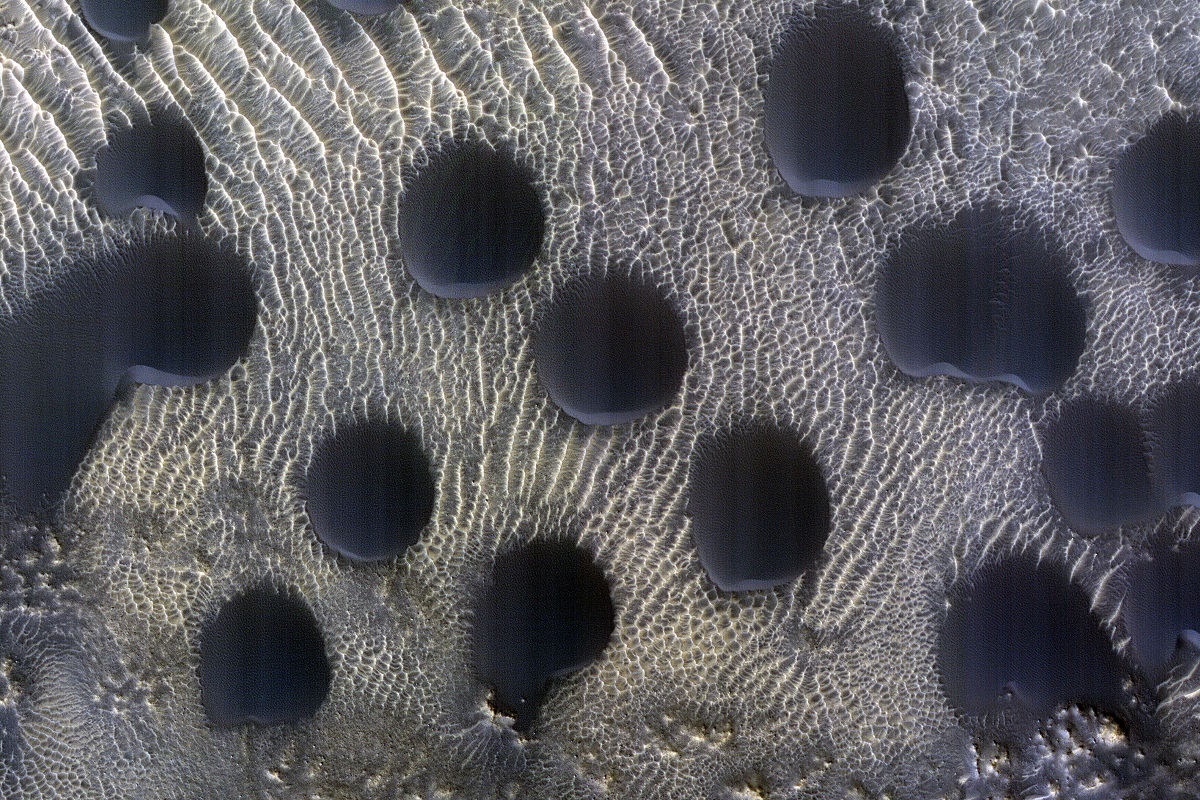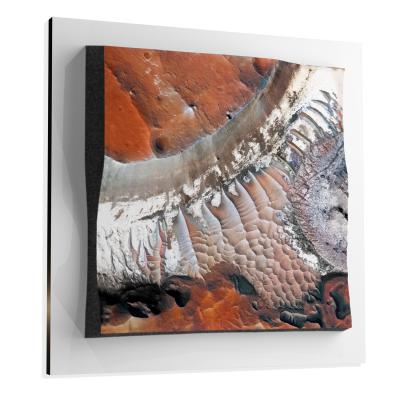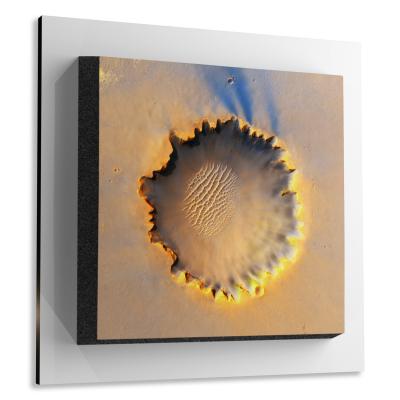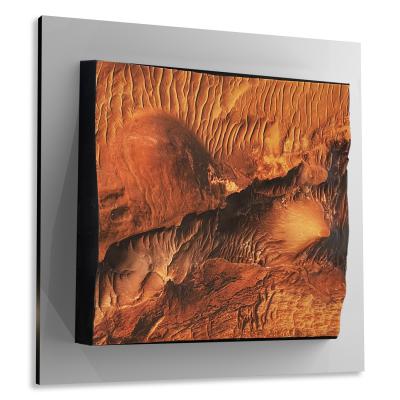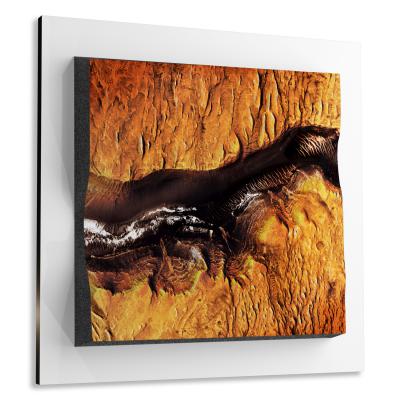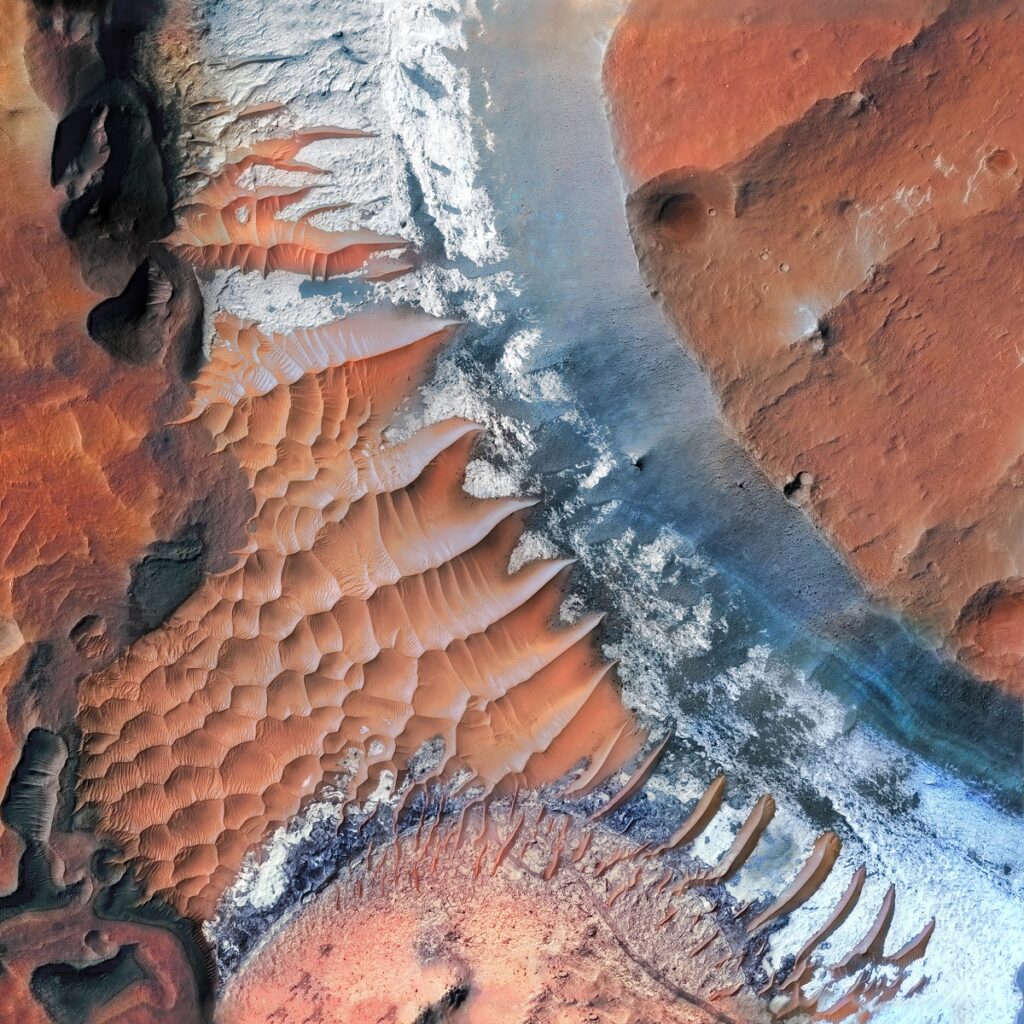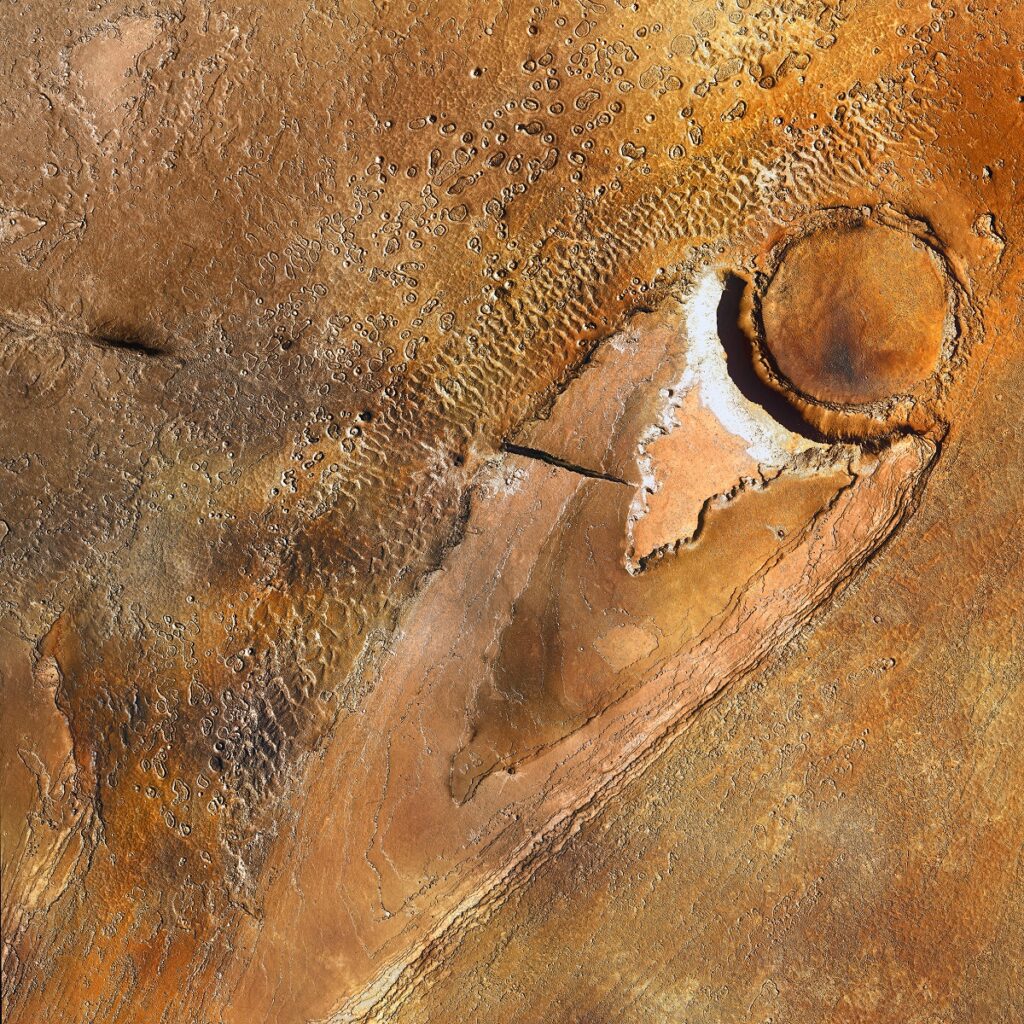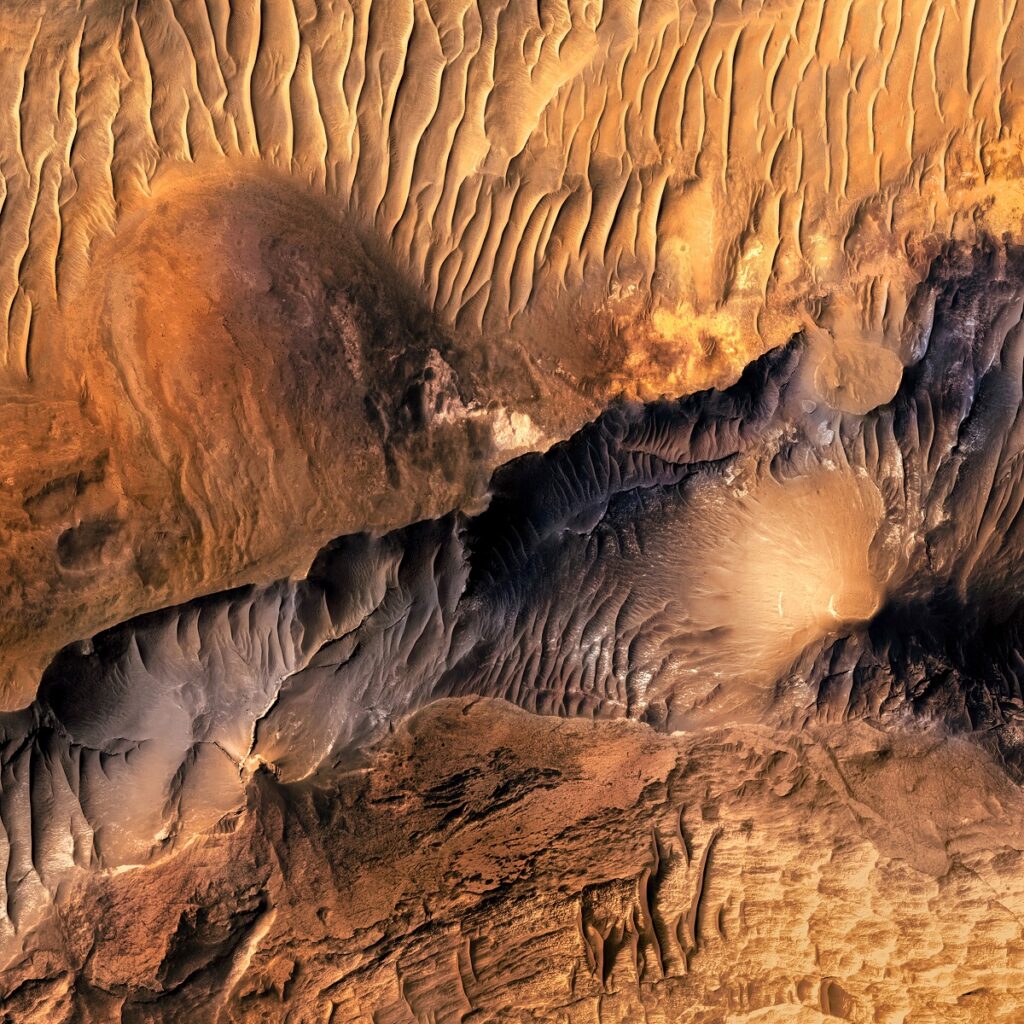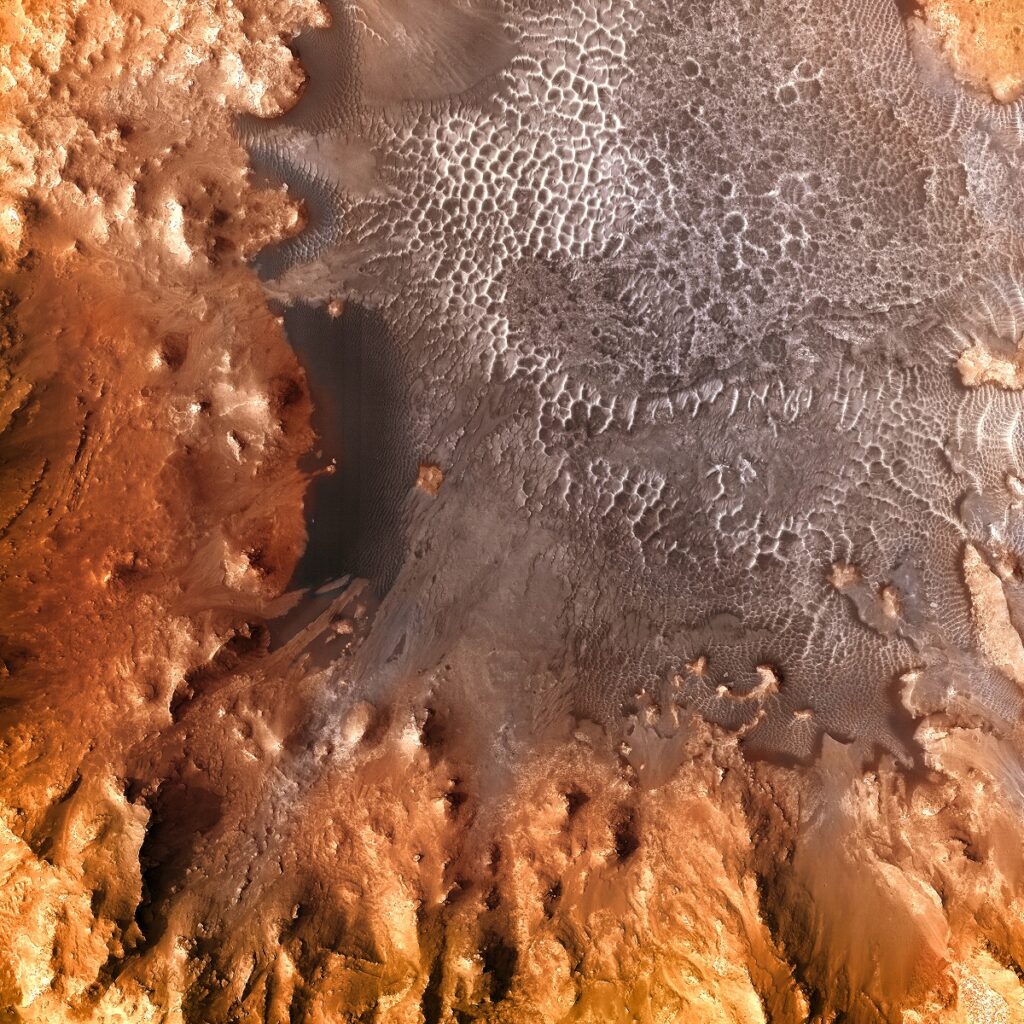Mars
Mars
The Ultimate Guide to the Red Planet
Mars
Mars, the fourth planet from the sun, has long held a special place in human consciousness. Commonly dubbed Earth’s “sister planet,” it bears certain resemblances to our home in terms of size and its position in the solar system. Its unmistakable reddish glint in the night sky is not just an astronomical wonder but also a rich tapestry of cultural and mythological significance. The planet derives its name from the Roman god of war, Mars, a testament to its fiery and captivating hue that has ignited human curiosity since ancient times.
This celestial body has been a cornerstone in our quest for understanding the cosmos. It’s not just a point of interest for its potential similarities or contrasts to Earth, but it represents the broader human yearning to explore the unknown. As our technological capabilities have advanced, our fascination has transformed into tangible exploration. Contemporary missions to Mars are peeling back the layers of this mysterious planet, and as each day passes, we are expanding our understanding and drawing connections between Mars, its history, and its potential to harbor life. This guide seeks to navigate the intricate maze of knowledge we have about Mars, taking you on a journey from its ancient past to the possibilities of the future.
Physical Characteristics
The quest to understand Mars is, in many ways, a journey of contrasts and comparisons with Earth. Among the most fundamental aspects of this understanding are the physical characteristics of Mars, which give insight into its formation, evolution, and the nature of its geology. When we think of planets, especially those in our own solar system, their size, mass, gravity, and internal composition are critical in painting a picture of their identity.
Size & Mass
Mars, often seen as Earth’s smaller sibling in the solar system, has a diameter of approximately 4,212 miles (6,779 km). To put this into perspective, this is just over half the size of Earth, which has a diameter of about 7,918 miles (12,742 km). This smaller size places Mars in a position of intrigue. Why didn’t it develop to the size of Earth? What factors during the early solar system led to this size difference? These are questions that planetary scientists are keen to answer.
Its mass further elucidates its diminutive nature compared to Earth. Mars has a mass that’s only about 11% of Earth’s, tipping the scales at approximately 6.42 x 10^23 kilograms. This smaller mass suggests not just a less dense planet, but also hints at differences in planetary formation processes and the materials available during its genesis.
Gravity
The gravitational pull a planet exerts is directly related to its mass and radius. With its significantly smaller mass, Mars has a gravitational force that’s just 38% of what we experience on Earth. To visualize this, imagine weighing 100 pounds (45 Kilograms) on Earth; on Mars, you’d feel as if you only weighed 85 pounds (38 kilograms).
This weaker gravity has substantial implications. It affects how tall mountains can grow before they collapse under their own weight (leading to the massive Olympus Mons) and how deep valleys can carve their way into the surface. Furthermore, the reduced gravitational pull has implications for any future manned missions or colonization attempts. Over extended periods, the human body would react differently under reduced gravity, with potential effects on bone density, muscle mass, and cardiovascular health.
Composition
Mars’ geology and the materials it’s composed of offer captivating insights into its history and the processes that have shaped it. At a glance, the Martian crust might seem somewhat familiar, primarily composed of basalt. Basalt, a type of volcanic rock, hints at a history of volcanic activity. It’s a rock we are familiar with on Earth, often found in places like Hawaii. The composition of Martian basalt, however, has its nuances and differences due to varying mineral contents and the environmental conditions under which it formed.
Digging deeper beneath the crust, Mars reveals an internal structure comprising a mantle and a large iron core. While Earth’s core is split into a liquid outer core and solid inner core, generating our planet’s magnetic field, Mars presents a puzzle. The Red Planet’s core is believed to be dormant. It doesn’t have the active magnetic field we see on Earth. This absence of a significant magnetic field has been the subject of much scientific interest. Without a protective magnetic shield, the solar wind has directly interacted with Mars’ atmosphere over billions of years, potentially playing a role in its thinning.
The Red Planet’s geography is a mosaic of wonder, complexity, and unprecedented scales that dwarf many of Earth’s geographical features. The Martian surface is a testament to eons of geological processes, meteoric impacts, and, possibly, the influence of water. A detailed exploration of its geography reveals stories of its past and tantalizing hints about its potential habitability.
Standout Surface Features
Dominated by vast plains, towering volcanoes, and expansive canyon systems, Mars is anything but monotonous. The standout feature, without a doubt, is Olympus Mons, the largest volcano in the solar system. Towering at approximately 13.6 miles (21.9 km) high, it surpasses even Mount Everest in sheer elevation. This shield volcano’s enormity is partially due to Mars’ lower surface gravity, allowing geological features to grow taller than they might on Earth. The base of Olympus Mons is roughly equivalent to the size of the state of Arizona. Its last eruption is believed to have taken place relatively recently in geological terms, hinting at a planet that is not entirely geologically dormant.
Equally awe-inspiring is the Valles Marineris canyon system. Carving its way across the Martian surface, it stretches over 2,500 miles (4,000 km) long, making the Grand Canyon seem almost quaint in comparison. It’s believed that this gigantic rift started as a crack billions of years ago, which then expanded due to erosional forces and perhaps even ancient water flow. The canyon plunges as deep as 4.3 miles (7 km) in places, revealing layers of the planet’s history.
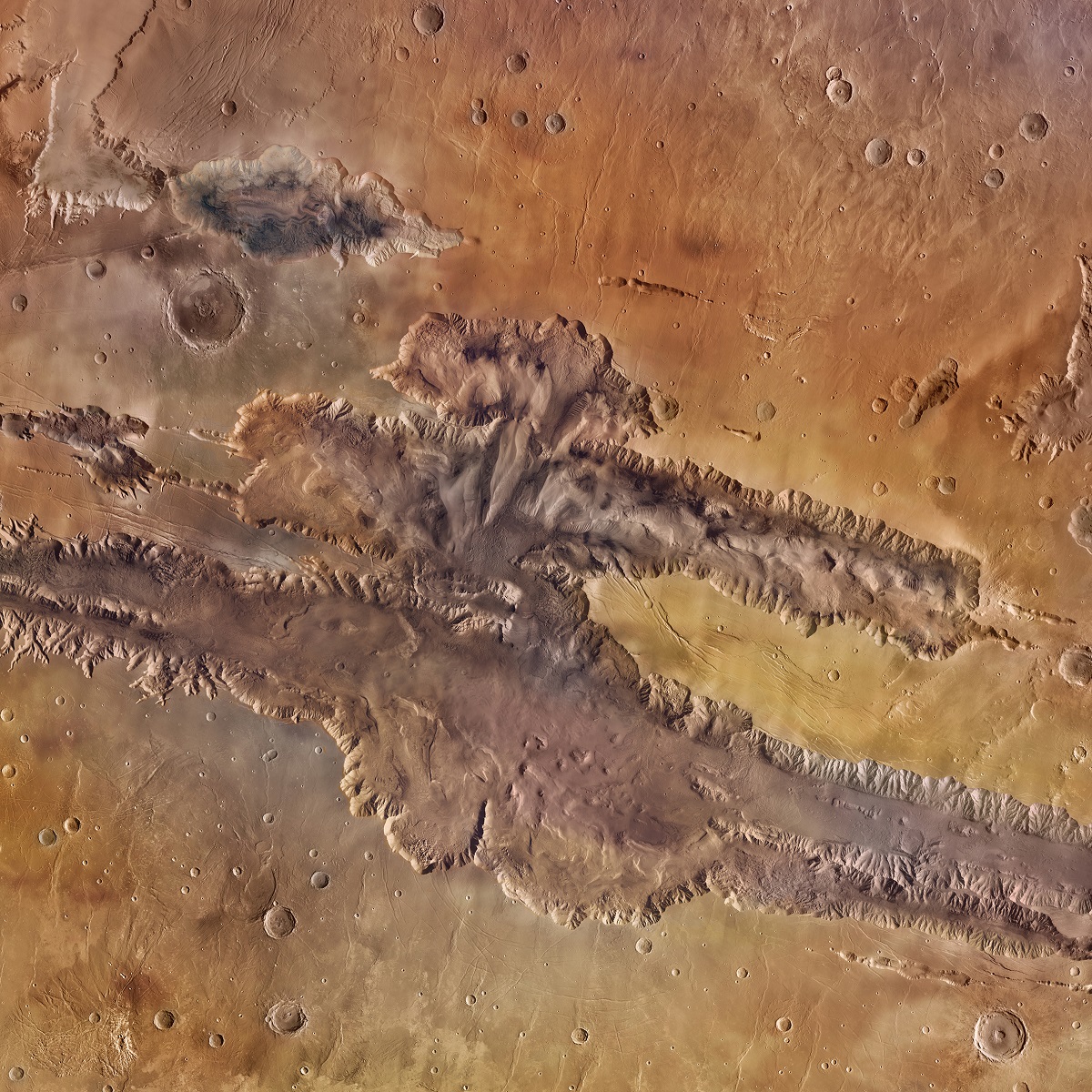 Valles Marineris
Valles Marineris
Polar Ice Caps
Reminiscent of Earth’s own polar regions, both of Mars’ poles are adorned with ice caps. These aren’t just stunning geographical features; they’re valuable reservoirs of information. Composed of water and carbon dioxide ice, these caps undergo seasonal changes. In the Martian winter, they expand as the polar temperatures drop and carbon dioxide condenses, adding to the ice cap’s volume. In contrast, during the summer months, a portion of the ice cap sublimates, turning directly from solid to gas, and causing the caps to recede.
This dynamic process is vital for scientists as it provides insights into Martian climate patterns and the planet’s potential water reservoirs. Recent studies suggest that the northern polar cap alone contains enough water ice to cover the entire planet with more than a meter of water if it were to melt.
Hemispherical Dichotomy
One of Mars’ most puzzling and prominent geographical features is the stark difference between its northern and southern hemispheres, often referred to as the Martian hemispherical dichotomy. The northern hemisphere largely consists of vast, flat plains, which are among the smoothest and flattest regions in the solar system. Contrasting sharply, the southern hemisphere is rugged, high-altitude terrain pockmarked with a dense array of craters.
Several theories attempt to explain this dichotomy. Some scientists believe it’s the result of a massive impact early in Mars’ history, where a celestial body collided with the planet, creating the smoother northern plains. Others argue for endogenic processes, suggesting that plate tectonics or convective currents in the planet’s mantle might be responsible.
This dichotomy isn’t just a geographical divide; it represents a chronological one. The heavily cratered southern highlands are ancient, preserving the planet’s early history. In contrast, the northern plains are relatively younger, shaped by later volcanic and potential fluvial activities.
Mountains of Mars
The Martian mountains stand as monumental narrators of the geological symphony that has reverberated through the Martian terrains over the aeons. These silent, magnificent sentinels bear witness to the myriad of volcanic eruptions, tumultuous tectonic shifts, and astronomical collisions that have shaped Mars, rendering each peak a reservoir of ancient planetary secrets. The multifarious mountainous structures that embellish Mars are significant keys unlocking the tales of the planet’s evolutionary odyssey and its inherent geological phenomena.
In the formidable collection of Martian mountains, Olympus Mons holds a position of unparalleled grandeur, reigning as the supreme shield volcano in the solar system, with its summit cresting at around 13.6 miles above the Martian surface. This monolithic behemoth is a living relic of the vibrant volcanic lifeblood that once pulsed through the veins of Mars, its sprawling caldera and extensive gentle slopes narrate the sagas of magmatic surges and effusive eruptions, illuminating the intriguing thermogeological dynamics of Mars.
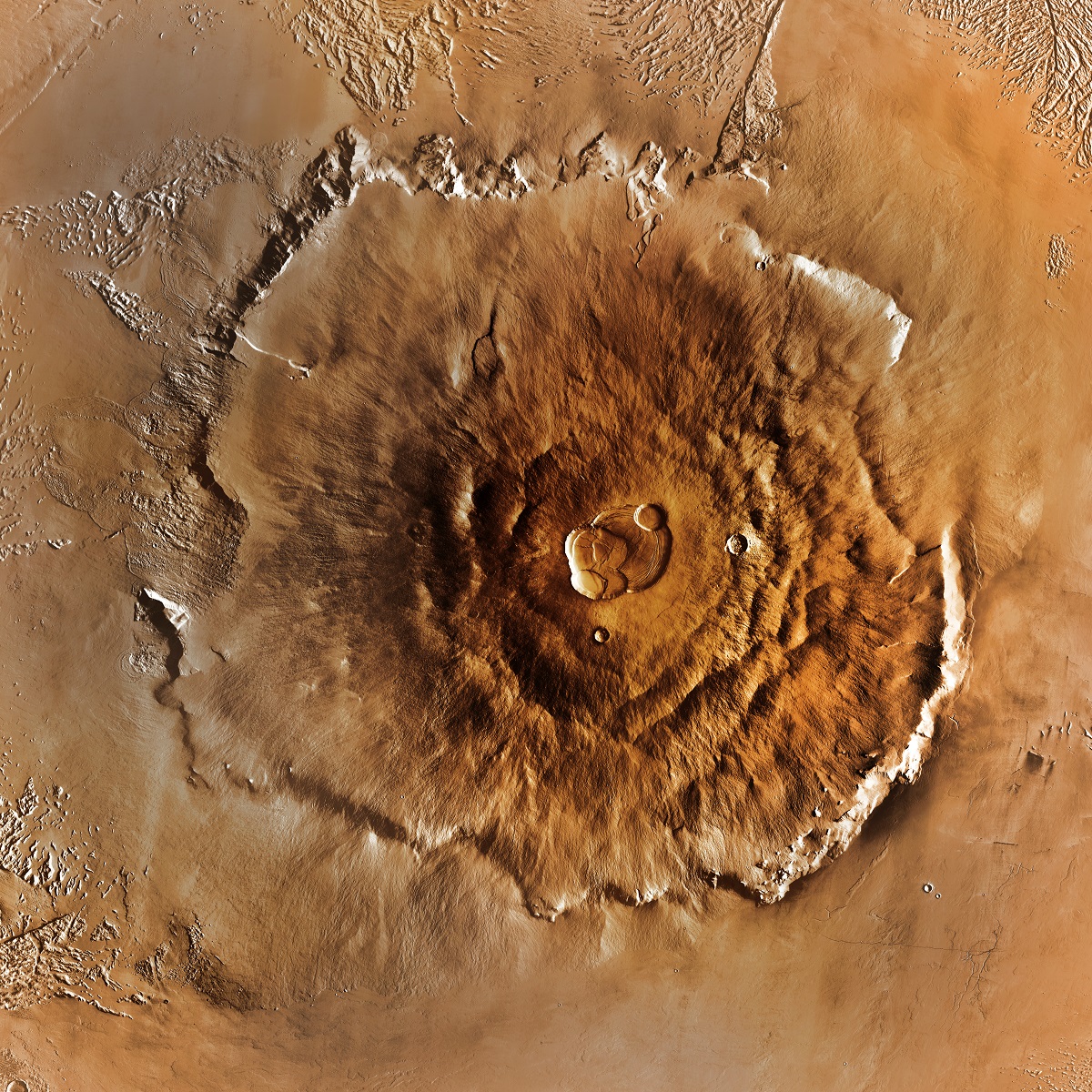 Olympus Mons
Olympus Mons
However, the mountainous narrative of Mars does not conclude with Olympus Mons. Ascraeus Mons, Pavonis Mons, and Arsia Mons are other prominent mountains, each unfolding a chapter of the Martian geological drama. Ascraeus Mons, one of the largest volcanoes on Mars, is another testament to the profound volcanic activity that has sculpted the Martian landscape. It’s intricate geological markers provide insights into the interaction between the volcanic processes and the Martian atmosphere, offering a panoramic view of the planet’s morphological evolution.
Pavonis Mons and Arsia Mons are other invaluable pieces in the Martian geological puzzle. These mountains, along with their unique structures and geological compositions, contribute significantly to our understanding of the variances in volcanic activity, atmospheric interactions, and surface modifications on Mars. The diverse textures and materials found in these mountains could reveal crucial information about Mars’ climatic past and its subsurface properties, adding dimensions to our comprehension of Martian geology and climate.
Each mountain on Mars is a repository of geological tales, revealing different aspects of the Martian surface. The remnants of impact craters, the patterns of erosion, and the layering of volcanic deposits on these mountains serve as geological fingerprints, offering a window into the transformations and adaptations the red planet has undergone through its existence. By studying these mountains, scientists can construct a coherent, multi-faceted history of Mars and can develop a profound understanding of the forces that have shaped it.
In addition to their geological significance, these mountains are critical locations for astrobiological explorations. They are considered potential habitats that might have harbored life, given their presumed interaction with water and other essential elements. The investigation of microbial habitats and the search for biochemical signatures within these mountains amplify our understanding of the possibilities of Martian life and add a new layer to the quest for extraterrestrial existence.
Craters of Mars
The craters on Mars stand as intriguing remnants and records of cosmic interplays, serving as the indelible scars and celestial imprints inscribed on the Martian canvas. These captivating impact structures are the keepers of historical tales, recounting the epochal events of cosmic collisions and meteoric bombardments that have molded Mars’ facade. Each crater, with its unique configurations, enshrines the chronicles of astronomical entities that have meandered through the solar system, sharing dynamic dialogues with the red planet.
Mars boasts a plethora of craters, each distinguished by its dimensions, profundity, and structural intricacies. Notable among them are the Gale, Schiaparelli, Hellas, and Gusev craters. The Gale Crater, with its layered mountainous center, reveals significant clues about Mars’s geological past and potentially habitable environments. The Schiaparelli Crater, with its vast diameter and prominent visibility, offers insights into the impact processes and subsequent modifications on Mars.
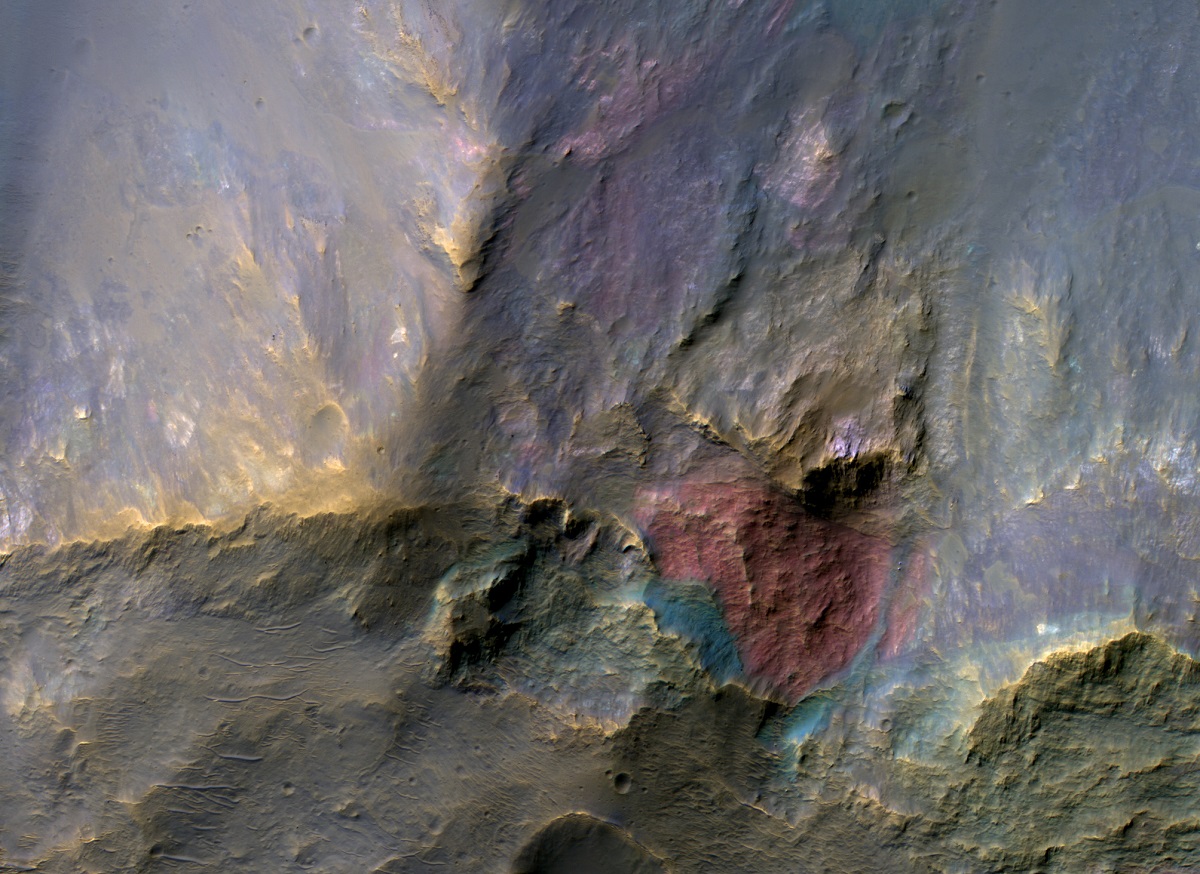 Crater Northeast of the Hellas Impact Basin
Crater Northeast of the Hellas Impact Basin
Hellas Planitia is another captivating crater, known for its immense basin, providing a glimpse into the catastrophic events and the subsequent alterations in the Martian surface. The study of such a monumental impact structure helps decipher the interactions between the Martian surface, atmosphere, and possible hydrosphere, weaving together the threads of Mars’s evolution. Gusev Crater, with its presumed ancient lakebed, ignites scientific curiosity due to the potential presence of past water and the prospects of unveiling ancient Martian biosignatures.
These diverse craters serve as portholes to the sequential unfolding of Mars’s geological and atmospheric tapestries. The meticulous examination of the contours, the substrate, and the erosional patterns of these craters enable scientists to extract invaluable information about the impacting celestial bodies and the compositional dynamics of Mars’s crust and atmosphere. They chronicle the varying chapters of Mars’s metamorphosis, depicting the transformations in its lithosphere and atmosphere over the aeons.
The role of craters extends beyond the geological narratives to include climatological and astrobiological investigations. Numerous craters provide compelling evidence of aqueous alterations and fluvial activities, alluding to the existence of liquid water in Mars’s bygone eras. These water-marked craters are the hotspots of astrobiological research, harboring the potential to conceal ancient life forms or preserve primordial biological traces, thus serving as the crucibles for unraveling the enigma of Martian life.
Diving into the craters also facilitates the reconstructions of Mars’s atmospheric odyssey. Assessing the cratering frequencies, erosional signatures, and sedimentary deposits help in delineating the historical atmospheric compositions and the climatic vicissitudes. Such analyses enrich our comprehension of the Martian climatic cycles and the environmental transitions, aiding in the synthesis of Mars’s atmospheric chronology.
The craters on Mars are also foundational for prospective manned Martian expeditions. They present tangible data on the potential resources, terrain hazards, and prospective landing and habitation zones, thereby guiding the logistical and strategic facets of future interplanetary endeavors. The cumulative knowledge derived from the exploration of Martian craters will be instrumental in navigating the intricate terrains and overcoming the multifarious challenges that lie in the path of human colonization of Mars.
Canyons of Mars
Mars cradles a myriad of canyons within its crust, each a colossal chasm chronicling the tales of the geological, climatological, and possibly, hydrological epochs of the enigmatic Red Planet. The intricate networks and monumental structures of these canyons present expansive terrains teeming with revelations about Mars’s transformative sojourn.
Valles Marineris stands preeminent among Martian canyons, a gargantuan rift system etching over 2,500 miles across the Martian facade, vastly surpassing the magnitude of Earth’s Grand Canyon. This monumental rift is a testament to Mars’s geological richness, its precipitous cliffs and profound troughs exposing the meticulously layered Martian crust, each layer whispering the secrets of a distinct era in the planetary annals. The origin and evolution of Valles Marineris engross the scientific realm, with emphasis on deciphering the myriad of tectonic activities and erosional phenomena that have sculpted its majesty.
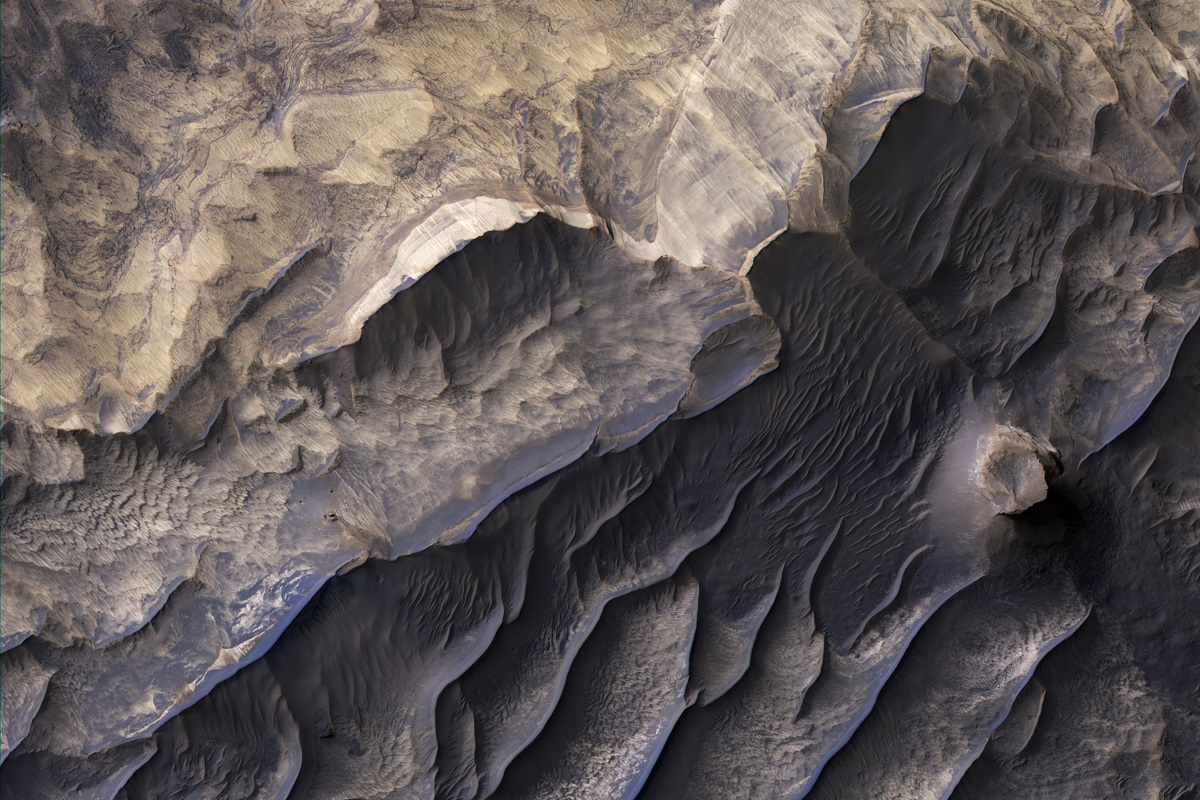 Sandstone in West Candor Chasma
Sandstone in West Candor Chasma
In addition to Valles Marineris, Mars is also home to other expansive canyons like Candor Chasma, Hebes Chasma, and Melas Chasma. Candor Chasma, a significant segment of the Valles Marineris system, unveils a multitude of layered deposits and landslides, enabling the exploration of Mars’s sedimentological history. Hebes Chasma offers a unique window to study the intricate interplay of volcanic activities, wind erosion, and potential water presence, each aspect shedding light on Mars’s dynamic past. Melas Chasma, characterized by its valley networks and diverse mineralogy, provides insights into the planet’s aqueous history and climatic variations.
These labyrinthine canyons serve as potential sanctuaries of erstwhile life. Their recesses and expanses reveal patterns of erosion and sedimentary residues, alluding to the plausible existence of liquid water in the primordial Martian landscapes. The speculated aquatic realms within the canyons have become the focal points of astrobiological endeavors, probing the prospects of ancient microbial ecosystems and the preservation of life’s imprints within these gargantuan structures.
Additionally, the exploration of Martian canyons is pivotal in elucidating the atmospheric and environmental narratives of the planet. The discernment of erosion imprints and mineralogical assortments within the canyons are instrumental in reconstructing the atmospheric paradigms and climatic shifts that have prevailed in Mars’s varied epochs. The intricate analysis of these canyons enables a synthesis of the environmental metamorphoses that have shaped the Martian vistas over the eons.
The inherent significance of these canyons transcends scientific inquiry, extending to the prospective human expedition and habitation of Mars. The shelter and resources proffered by these canyons are paramount in evaluating the feasibility of fostering human settlements on the Martian terra firma. The meticulous assessment of the geological architectures and the resource matrices of these canyons is fundamental in orchestrating strategies for enduring human acclimatization on Mars.
Lakes of Mars
Mars, with its landscapes painted by the poetic brushes of time and environmental metamorphosis, conceals within its terrains tales of primordial lakes, the remnants of which are etched into its crust. These ancient reservoirs are monumental, serving as windows to the climatic tales and possible biological odysseys of Mars, offering priceless insights into its intricate history.
Substantial and persuasive evidence suggests the existence of numerous ancient lakes scattered across the Martian landscape. Features reminiscent of terrestrial lakes, such as deltaic deposits, stratified sedimentary structures, and the scars of erosion and water flow, bear testimony to the erstwhile presence of tranquil water bodies. These relics are instrumental in understanding Mars’s antique hydrological tales, aiding scientists in recreating the environmental tapestry wherein these lakes nestled. The revelation of minerals and layered stratigraphy within these lakebeds are significant, disclosing the chemical characteristics of ancient Martian waters and illuminating their potential to host life.
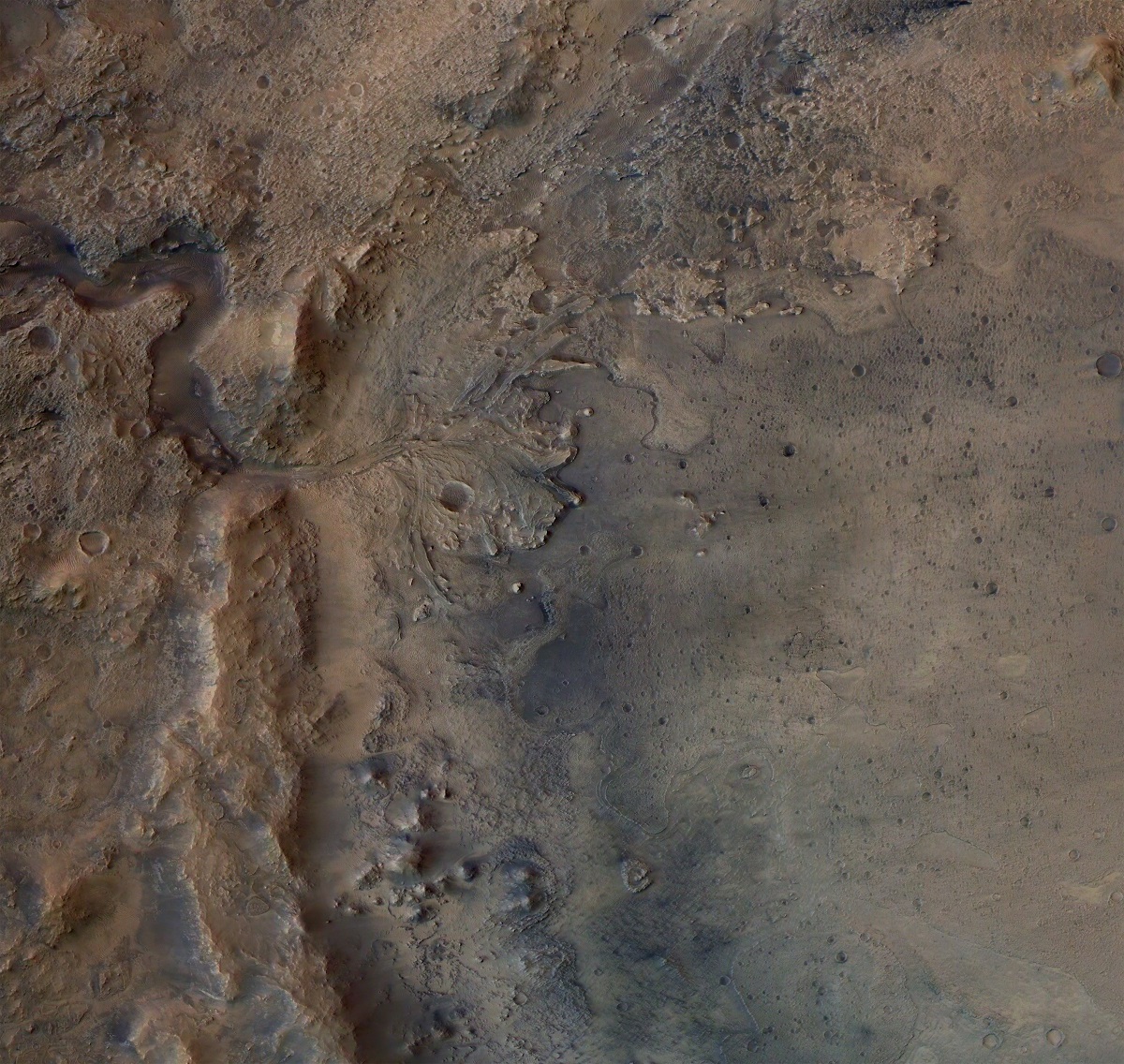 Jezero Crater Delta
Jezero Crater Delta
Lakes such as Eridania Lake, Gale Crater Lake, Holden Crater Lake, and Jezero Crater Lake are particularly notable. Eridania Lake, speculated to be one of the ancient lakes, potentially harbored conditions conducive to microbial life, its remnants whispering the songs of primordial waters. Gale Crater Lake, with its preserved sediments, serves as a scientific treasure trove, chronicling Mars’s transition from a warmer and wetter climate to the present arid state. Holden Crater Lake, with its intricate network of valleys, hints at prolonged water activity, offering glimpses into Mars’s aqueous history. Jezero Crater Lake stands as a beacon of astrobiological potential, its deltaic deposits concealing the secrets of Mars’s primitive ecosystems.
The lakes of ancient Mars are the focal points in the perennial quest to decipher the enigma of Martian life. These lakes, with their tranquil waters and nourishing minerals, would have been the sanctuaries for microbial entities, if they ever existed. The relentless exploration and analysis of these lakebeds are at the heart of astrobiological pursuits, with researchers delving deep into Martian rocks, seeking the echoes of organic molecules or traces of fossilized microbial entities.
These ancient lakes are also embodiments of Mars’s atmospheric and climatic transitions. They suggest a past where a denser atmosphere swathed Mars, allowing a warmer climate to cradle liquid water on its surface. The detailed examination of these lakes is crucial, providing a comparative framework to align Mars’s geological evolution with Earth’s, thus painting a coherent picture of planetary habitability and atmospheric transformations.
Moreover, the whispers of these lakes are guiding points for future interplanetary explorations and potential human colonization. The profound understanding of the geological and environmental nuances of these ancient water bodies is indispensable for strategizing human settlements and exploiting Martian resources.
Volcanoes of Mars
Volcanoes are seminal elements in Mars’ diverse geological narrative, acting as the colossal sculptors and meticulous recorders of the planet’s vibrant metamorphosis. These towering edifices have been the cradle of the Martian landscapes, their fiery symphonies playing a crucial role in crafting the geological and climatic sagas of Mars.
Olympus Mons stands as the supreme ruler amidst Mars’ volcanic entities, its immense shield marking it as the largest volcano and the highest mountain in our solar system, with elevations extending to approximately 13.6 miles. This formidable giant narrates the saga of Mars’ fervent volcanic chapters, its expansive slopes and vast caldera etching the tales of myriad eruptions into Martian history. This enormous structure provides an unparalleled glimpse into the magmatic choreography and internal dynamics that have given form to the Martian volcanic landscapes.
Beyond Olympus Mons, Mars houses other notable volcanic titans such as Ascraeus Mons, Arsia Mons, and Pavonis Mons, each contributing to Mars’s geological symphony in unique tones. Ascraeus Mons and its compatriots unravel diverse facets of Martian vulcanism, their morphologies and lava compositions extending the understanding of Mars’s volcanic and tectonic evolution.
The exploration and study of Martian volcanoes are deeply embedded in the quest to understand the intricate relationship between vulcanism and atmospheric transitions. The fiery breath of these volcanoes, laden with gases like carbon dioxide, water vapor, and sulfur dioxide, has been instrumental in shaping and modifying the Martian atmosphere. By scrutinizing the volcanic relics and discerning the elemental tapestries within, scientists can extrapolate the volatile contributions of these volcanoes to the atmospheric and climatic tableau of Mars over its geological epochs.
The plains caressed by the ancient lava flows stand as silent witnesses to Mars’s potential for harboring life. The fertile volcanic soils, enriched with minerals and possibly interlaced with water from volcanic exhalations, may have cradled ecosystems teeming with microbial entities. Thus, the traversing of volcanic landscapes is interlaced with the hunt for ancient Martian life, as scientists sift through the Martian soils in search of vestiges of bygone organisms.
Additionally, the Martian volcanic realms are pivotal focal points for impending exploration missions and prospective colonization initiatives. These regions are reservoirs of invaluable resources and potential geothermal energy, necessitating meticulous exploration and assessment to optimize the extraction and utilization of these geological treasures.
Rivers of Mars
Mars, the epitome of celestial enigma and myriad contrasts, conceals within its red sands the imprints of primordial river systems, whispering to us the echoes of its watery heritage. These remnants of ancient rivers play a pivotal role in the relentless pursuit to unravel Mars’s intricate hydrological tapestry and to scrutinize its erstwhile habitability.
The traces of Martian rivers, intricately carved into its façade, narrate the sagas of waters that once danced upon its surface, shedding light on the existence of a vibrant water cycle in Mars’s primordial days. These valleys, with their sinuous and dendritic contours, bear the marks of erosion and sediment movement, indicative of water’s dance across the Martian surface. The semblance of these ancient waterways to terrestrial rivers enables scientists to craft parallels and deduce the environmental and hydrological scenarios that once painted the Martian canvas.
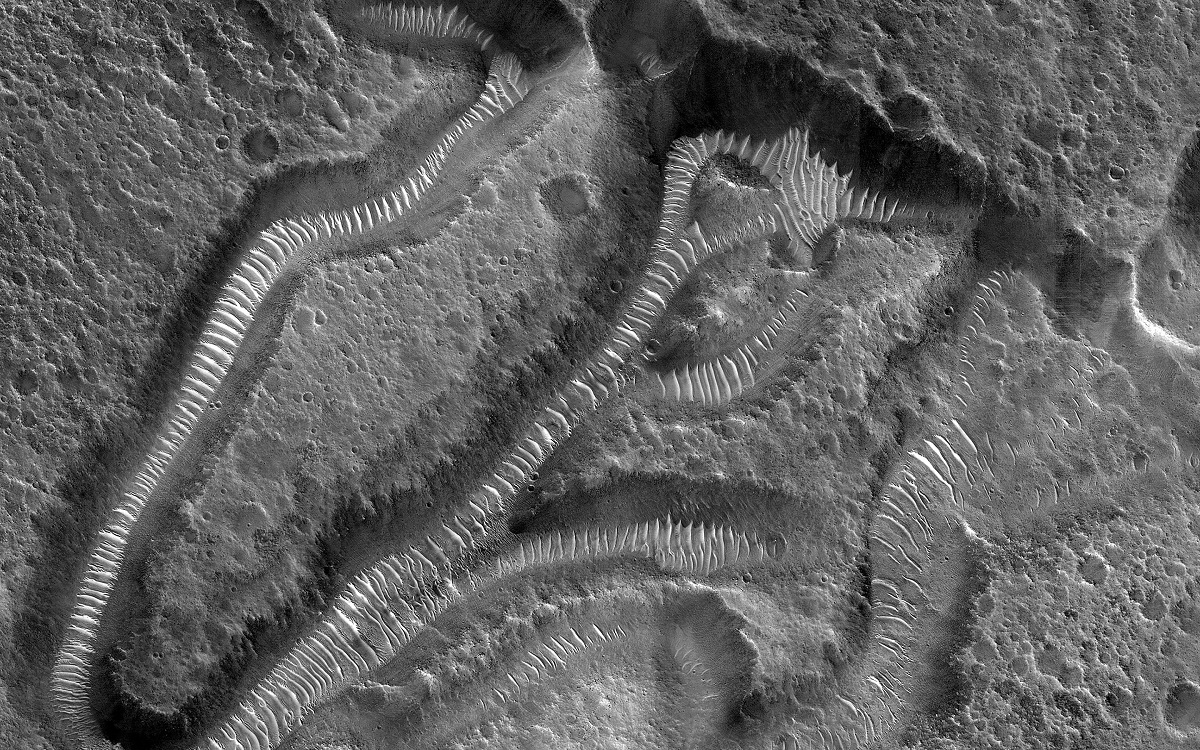 Channels on a Streamlined Island of Kasei Vallis
Channels on a Streamlined Island of Kasei Vallis
Among the relics of these river systems, we find colossal entities like Kasei Valles, Ares Vallis, and Ma’adim Vallis, each holding distinct tales of Mars’s aqueous ballet. Kasei Valles, with its intricate channels, whispers of massive floods that once sculpted its terrains, while Ares Vallis and Ma’adim Vallis unfold their unique accounts of the planet’s hydrological dance, presenting myriad opportunities for exploration and study.
Exploration of these river remnants unveils clues about the climatic interludes that embraced the existence of liquid water on Mars, suggesting that Mars, in its ancient chapters, boasted a more robust atmosphere, capable of cradling liquid water and potentially, nourishing life. These silent rivers unveil nuances of the Martian water cycle, encompassing precipitation, flow, and evaporation, elucidating their roles in molding Martian landscapes and climatic anecdotes.
Moreover, these aquatic tapestries harbor immense potential for astrobiological revelations. The ancient riverine ecosystems could have been sanctuaries for microbial existence, providing consistent hydration, abundant nutrients, and varied energy resources. Consequently, the investigation of Martian riverine sediments is inseparably entwined with the quest for ancient Martian life, as the hunt for organic remnants and possible fossilized microbial entities intensifies within these fluvial relics.
Sand Dunes of Mars
Mars, with its fluctuating landscapes and the murmurs of its wandering winds, cradles an array of sand dunes, each narrating the symphonies of Martian winds and granules. These dunes are not merely geographical entities; they are dynamic sculptures evolving to depict the intricate ballet between Mars’ atmospheric whims and its terrestrial whispers, rendering pivotal insights into the Martian environmental and climatic tapestries.
Amongst Mars’ myriad dunes, entities like the Bagnold Dunes, the Ogygis Undae, and the Abalos Undae stand out, each resonating with distinct tales of the Martian aeolian waltz. The Bagnold Dunes, whisper tales of perpetual transformation under the Martian winds. In contrast, Ogygis and Abalos Undae, with their distinctive morphologies and textures, narrate the myriad tales of the atmospheric dance and granular symphonies sculpting the Martian landscapes.
The harmonious interplay between the Martian winds and the granular symphonies results in diverse dune portraits, from the crescent whispers of barchans to the linear harmonies and stellar silhouettes of other dunes. Each dune, with its individual morphology and texture, is a chapter detailing the characteristics of the orchestrating winds and the participating grains. Analyzing these dune creations and their migratory tales enable the deciphering of the aerodynamic and sedimentological sonatas painting the Martian landscapes.
Moreover, the symphonies between the sand dunes and the atmospheric breaths unveil the delicate threads of Mars’ climatic ballet. The transmutations and migrations of the dunes are the barometers to the seasonal and annual alterations in Martian winds, atmospheric breaths, and thermal whispers. The evolution of the dunes encapsulates the rhythmic beats of Martian climates, offering a dynamic lens to observe the sequential alterations in Martian environments.
The Martian dunes are also speculated to be potential sanctuaries for microbial symphonies. Nestled within the sands are potential microhabitats, possibly cradling water molecules and organic echoes, veiled from the Martian extremities. Thus, the exploration into the Martian dunes is a pursuit for concealed biosignatures, with endeavors delving into the granular realms in search of possible microbial echoes or their chemical remnants.
Furthermore, the dynamic tales of the sand dunes are instrumental for impending explorative symphonies on Mars. Comprehending the dunes’ dances and drifts is crucial for maneuvering through the Martian landscapes and utilizing in situ resources, securing the safety and triumph of missions meandering through the sandy symphonies.
Caves of Mars
The Martian canvas, a boundless realm of geological spectacles and primordial enigmas, is imbued with the enigmatic charm of its caves. These underground sanctuaries beckon with whispers of Mars’ enshrouded chronicles, holding the echoes of knowledge within their shadowed confines. They are the keepers of Mars’ untold sagas, cradling the secrets of the planet’s geological, climatological, and perhaps, biological lineage within their recesses.
Among the diverse subterranean structures of Mars, caves like the Hellas Planitia Caves, Arsia Mons Caves, and the Pit Craters of Tractus Fossae, hold pivotal roles in unearthing the red planet’s clandestine tales. Each one of these cavernous realms, with their unique formations and attributes, has a different story to narrate about Mars’ metamorphosis, offering an intimate view into its diverse geological processes and hidden histories.
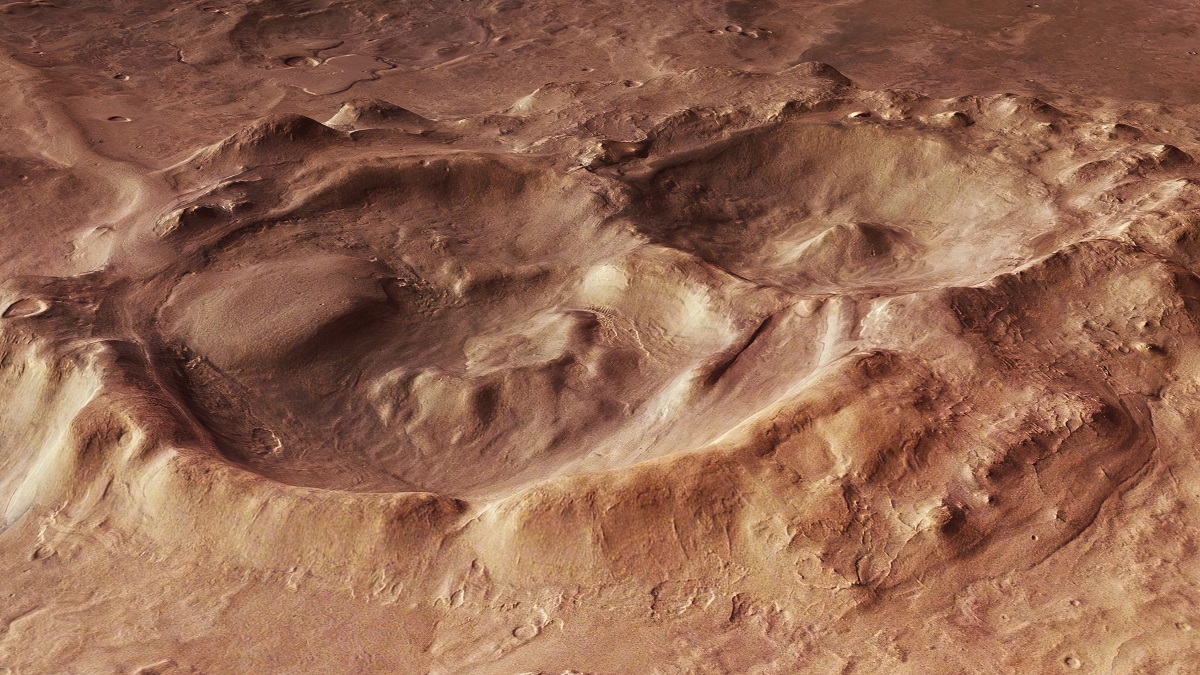 Caves within Hellas Basin
Caves within Hellas Basin
These Martian caves are portals to the clandestine layers of the planet, offering privileged insights into the myriad processes that have molded the Martian crust. Carved by the hands of volcanic pulsations, erosive whispers, and celestial impacts, these caves are the silent witnesses to Mars’ diverse morphological journey. Diving into these caves allows us to thread the labyrinth of volcanic narratives, erosional imprints, and tectonic dialogues that have painted Mars’ geological tapestry, deepening our comprehension of its dynamic geological odyssey.
Furthermore, the caves are the silent holders of Mars’ climatological secrets. Their interiors, veiled from the abrasive elements, capture the ancient climatic symphonies and atmospheric compositions within their sheltered realms. Analyzing the breaths of these caves and their crystalline formations yields precious revelations about Mars’ climatic fluctuations, atmospheric elements, and thermal dances. They serve as climatological relics, preserving the ephemeral tunes of Mars’ atmospheric ballet.
In the ongoing quest to unravel the mysteries of extraterrestrial existence, the caves of Mars pose as probable sanctuaries for erstwhile or extant life forms. These underground worlds, with their tranquil environments and shields against solar whispers, could have been refuges for microbial entities. The expedition for Martian life pierces the quiet sanctuaries of these caves, as the seekers of truth explore for the spectral echoes of biological presence or the chemical resonances of organic echoes, probing the enigma of a hidden biosphere beneath Mars’ regolith.
The exploration and study of Martian caves also have profound ramifications for forthcoming human endeavors on Mars. These subterranean realms could serve as natural protective abodes for astronauts, offering respite from the formidable Martian elements and cosmic whispers. Assessing the viability of these caves as potential dwellings is integral to the strategies and realizations of human ventures on Mars, impacting the choice of descent locales and habitat conceptions.
Regions of Mars
Mars, a celestial reservoir of ancient enigmas and eclectic terrains, is compartmentalized into several unique regions, each bearing witness to the planet’s intricate geological saga and a plethora of environmental spectacles. The Tharsis Montes, the Arabia Terra, and the Elysium Planitia, are some of the prominent regions, distinctly marked by varied topography, geology, and climate. They act as panoramic portals into Mars’s diversified landscapes, playing a pivotal role in deciphering the evolutionary chronicles of Mars.
The variegated landscapes of Mars, embellished with formidable mountain ridges, boundless plains, profound canyons, and colossal impact basins, underscore the regional heterogeneity of the planet. Each Martian region unfolds a singular array of geological attributes and formations, offering invaluable insights and aiding scientists in unraveling the labyrinth of Martian geological metamorphosis. The diverse topography and geological disparities across regions manifest the myriad tectonic, volcanic, erosional, and impact dynamics that have molded Mars through eons.
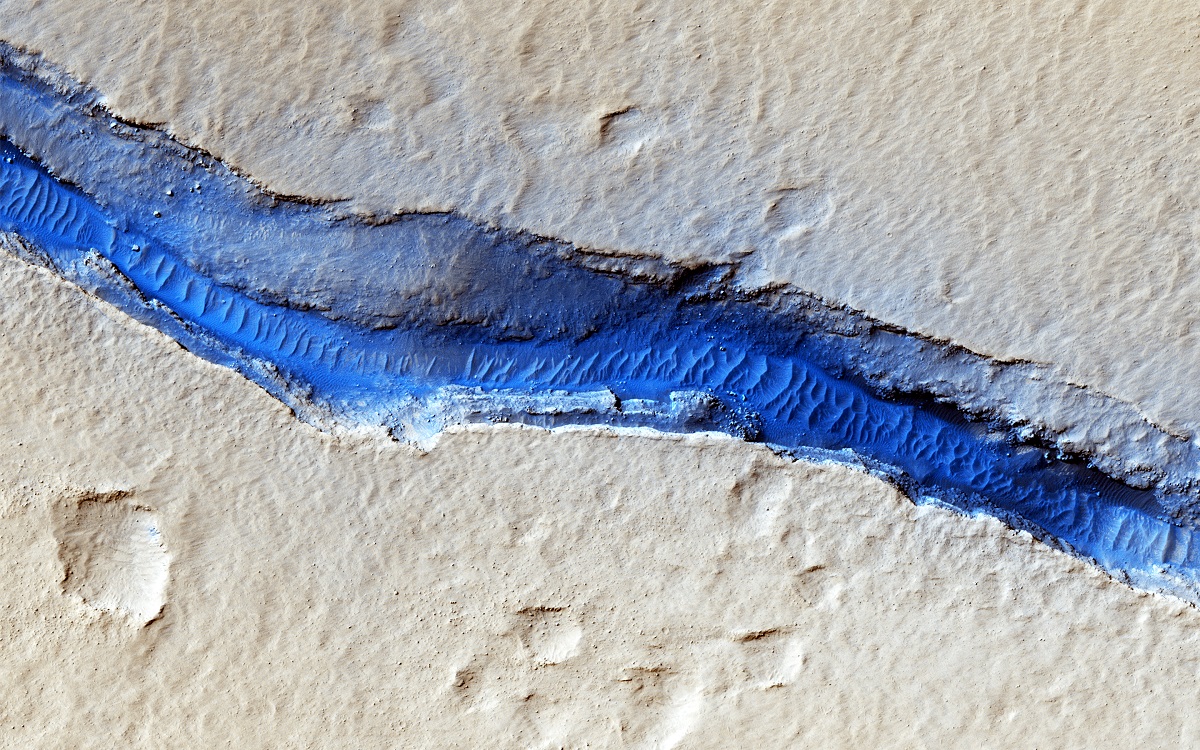 Plains in the Southeastern Region of Elysium Planitia
Plains in the Southeastern Region of Elysium Planitia
Beyond the geological realms, Mars’s regions are climatic treasuries, encapsulating the myriad atmospherical and environmental modulations across the planet. The climatic divergences amongst regions mirror the intricate liaison between Martian atmospheres, relief features, and solar interactions, sketching a kaleidoscopic tableau of Mars’s environmental evolution. Probing into these regional climates elucidates the archaic climatic transitions and atmospheric modifications, enhancing the comprehension of the Martian climatic tapestry.
Furthermore, venturing into Mars’s multifaceted regions engenders astrobiological connotations. The environmental disparity between regions predicates varied habitability potentials, potentially concealing distinct ecological sanctuaries. Hence, the pursuit of Martian life is inherently regional, as scientists scrutinize the plethora of Martian realms in search of biological imprints or conducive habitats.
Additionally, the exploration of the distinct Martian regions is foundational for conceptualizing future human expeditions. Evaluating the availability of resources, potential risks, and habitability across regions is crucial in determining apt landing sites and conceiving sustainable living adaptations. Acquiring an in-depth apprehension of regional attributes is paramount for ensuring the well-being and triumphant accomplishments of human missions on Martian terrains.
Plains of Mars
Mars’ extensive plains, immense tracts of flat landscapes, recount the chronicles of the celestial body’s bygone eras, encapsulating the mute murmurs of the elapsed eons. Notable amongst them are the Utopia Planitia, Amazonis Planitia, Elysium Planitia, and the Isidis Planitia, each a unique reservoir of Martian lore. These boundless terrains play a pivotal role in deciphering the Martian geological, and perhaps, biological antiquity, serving as treasuries of the imprints begotten by the manifold processes that have sculpted Mars over countless millennia.
These Martian plains serve as unabridged manuscripts of the planet’s antiquity, laying bare the geological sagas that have unfolded therein. They boast predominantly level and streamlined terrains, which sprawl endlessly, kissing the horizons with their widespread embraces. These domains afford insights into the planet’s sedimentary chronicles and whisper about the integral roles of water, air, and frost in molding the Martian topography. They are the canvases where geological and erosive narratives have drawn the episodic symphony of Mars’ vibrant history.
Diving into the secrets of these plains facilitates a journey into the enigma of Mars’ climatic metamorphosis. The structure and makeup of the soils and monoliths interspersed across these plains provide hints to the atmospheric legacies and climatic modulations of yore. Unearthing these clues is foundational for reconstructing the sequential climatic transmutations of Mars and revealing the ecological revolutions that have marked the Martian terrains.
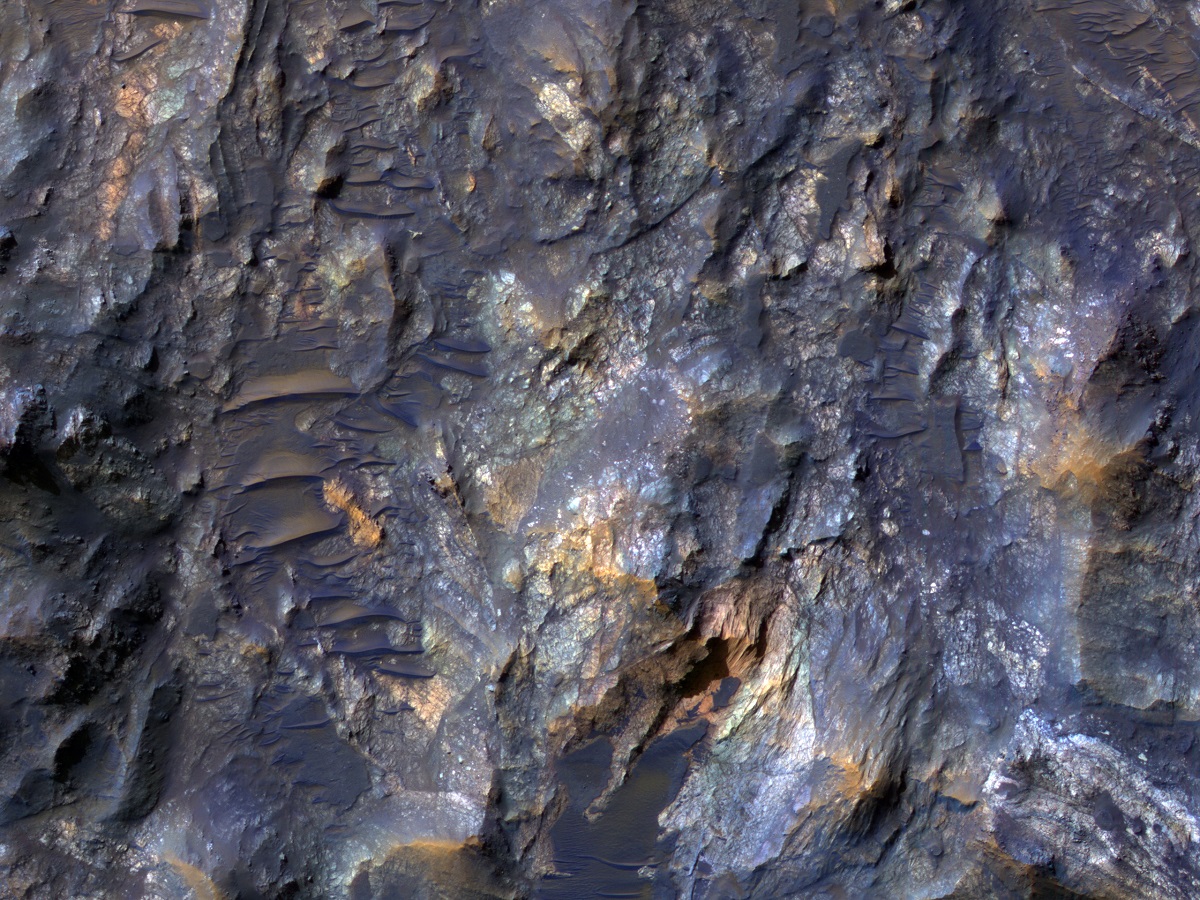 Volcanic plains between Argyre Planitia and Valles Marineris
Volcanic plains between Argyre Planitia and Valles Marineris
The quest for Martian life is profoundly linked to the exploration of these plains. These extensive, level expanses are potential crucibles for discerning traces of primeval life or markers of microbial actions. It’s conjectured that these plains were cradles to aqueous bodies in Mars’ youth, potentially furnishing the indispensable prerequisites for life to burgeon and flourish. The roving sentinels traversing the Martian plains are in relentless pursuit of any biosignatures that could attest to the presence of erstwhile life forms in Mars’ ancient realms.
Moreover, the Martian plains are viewed as prospective arenas for impending human explorations and settlements. The relatively even and unobstructed landscapes are optimal for landings, and their expansive stretches are conducive for erecting human abodes and stationing exploratory apparatuses. With their presumed resource richness, the plains emerge as strategic anchors for maintaining human existence on this alien world.
Ridges of Mars
The Martian ridges, complex geological formations, traverse the Martian expanse, representing the planet’s vascular system. Notable ridges like Medusae Fossae, Nili Fossae, and the Western Colles, embody the intricate details of the planet’s geological metamorphosis. These elongated eminences, often rising from Mars’ crust, are crucial in deciphering Mars’ geologic saga, resonating with the myriad metamorphoses the celestial body has experienced.
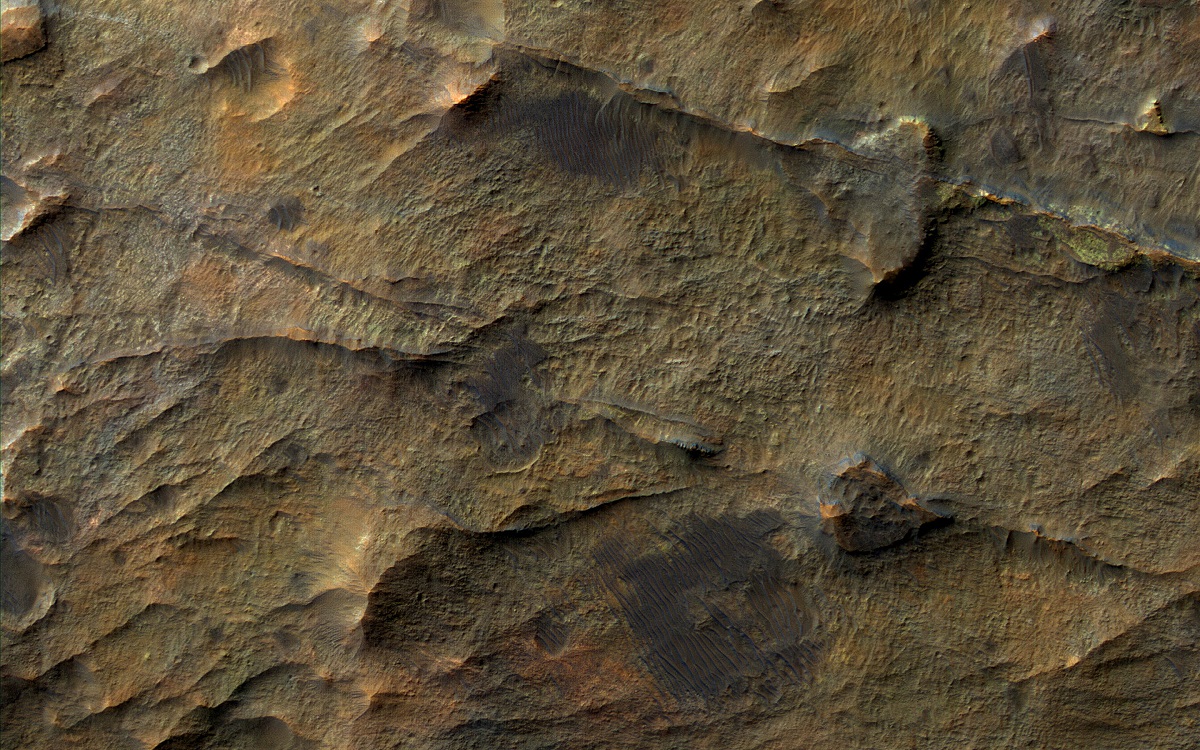 Ridges Near Nirgal Valles
Ridges Near Nirgal Valles
These Martian ridges exhibit a diverse array, each narrating a distinct chronicle of creation and transformation. They stand as silent sentinels to a range of geological activities including tectonic shifts and fluid alterations, each delineating the contours of Mars. Linked with ancient lava fluxes, fracture domains, and impact crater remnants, ridges insinuate varied creation theories and enrich the understanding of the diverse geological symphony enacted on Mars. Probing these ridges enables scientists to traverse the annals of Martian epochs and decipher the evolutionary odyssey of its geology.
However, the significance of Martian ridges transcends their geological prominence; they are pivotal in unraveling Mars’ environmental annals. Ridges might conceal traces of erstwhile hydrological phenomena, hypothesized to be the progenies of subterranean water or ice channels. Scrutinizing their composition and structural elements divulges insights into Mars’ water histories and uncovers the climatic paradigms dominating diverse geological eras. Comprehending the symbiotic relationships between ridges and the Martian milieu is essential for crafting a consolidated portrayal of Mars’ atmospheric and climate transitions.
Furthermore, the expedition into Martian ridges has potent astrobiological repercussions. If the water indeed was a sculptor of these ridges, it’s plausible that they encase remnants of primordial life or indicators of previously habitable environments. Unearthing biosignatures or recognizing life-sustaining alcoves within the ridges can be groundbreaking in the relentless pursuit of Martian life, elevating our understanding of Mars’ latent life-supporting capacities.
Advertisement
Sample Marscapes
Mars Atmosphere
The Martian atmosphere, while vastly different from Earth’s, holds many keys to understanding the planet’s history, its current conditions, and its potential for future exploration. This thin veil of gases provides insights into the planet’s geological and possibly hydrological processes, shaping our understanding of Mars as a whole. To truly appreciate the atmosphere of Mars, one must delve into its composition, its unique optical effects, and its implications for the planet and space exploration.
Composition
Mars’ atmosphere is predominantly composed of carbon dioxide (CO2), accounting for a staggering 95.3% of its composition. This is in stark contrast to Earth’s atmosphere, where CO2 makes up only about 0.04%. Accompanying carbon dioxide, nitrogen (N2) contributes to about 2.7% and argon (Ar) at 1.6%. Other trace gases, such as oxygen (O2) and water vapor (H2O), are present but in minuscule amounts.
This dominance of carbon dioxide, coupled with the atmosphere’s thin nature, results in an environment vastly different from what we know on Earth. The atmospheric pressure at the Martian surface is less than 1% of Earth’s. Such low pressure means that even if the temperature were right, liquid water would either freeze or evaporate rapidly on the surface.
The sparse atmosphere also influences the planet’s temperature. Though carbon dioxide is a greenhouse gas, the thin atmosphere means Mars doesn’t benefit from a strong greenhouse effect. This results in an average surface temperature of about -80 degrees Fahrenheit (-62 degrees Celsius), with winter temperatures plummeting even lower.
Optical Phenomena
One of the intriguing outcomes of Mars’ atmospheric composition is the way it scatters sunlight, leading to a visual spectacle that’s a reversal of what we’re accustomed to on Earth. On our blue planet, shorter blue wavelengths of sunlight scatter in every direction, giving our sky its characteristic color during the day. However, the longer red wavelengths become more prominent during sunrises and sunsets, casting a reddish hue.
On Mars, the opposite effect occurs due to the fine dust particles suspended in the atmosphere. These particles are adept at scattering the longer red wavelengths, giving the Martian sky a butterscotch or slightly reddish tint during the day. However, when the sun is low on the horizon during sunrises and sunsets, the shorter blue and green wavelengths dominate, resulting in azure sunsets and sunrises. This Martian atmospheric spectacle is one of the many wonders that await future astronauts and colonists.
Implications and Considerations
The thin and CO2-rich atmosphere of Mars presents both challenges and opportunities. For any future human explorers or settlers, the Martian atmosphere is unsuitable for breathing. Not only is it thin, creating conditions similar to those at an altitude of 35 km (22 miles) on Earth, but the high CO2 content is also toxic to humans. Thus, habitats would need to be pressurized and possess life support systems to provide breathable air.
However, the atmosphere’s rich CO2 content also presents potential opportunities. Scientists and engineers have been exploring technologies that could extract oxygen from the carbon dioxide or utilize it to produce methane (CH4), which could be used as rocket fuel.
Mars Climate
Mars, a celestial body of intrigue, harbors a climate that is as enigmatic as it is diverse. The Martian climate is marked by its thin atmosphere, composed predominantly of carbon dioxide, which has a profound impact on the weather, temperature, and overall climatic conditions of the planet.
Temperature Extremes
Mars experiences a wide range of temperatures, from highs that can reach up to 68°F (20°C) near the equator, to lows plummeting to -243°F (-153°C) at the poles. The significant temperature fluctuations are attributed to Mars’ thin atmosphere, which is incapable of trapping heat from the Sun efficiently. This results in rapid cooling and heating of the Martian surface, rendering the planet’s climate extremely cold, with a mean temperature around -80 degrees Fahrenheit (-62°C).
Atmospheric Conditions
Mars’ atmosphere is over 100 times thinner than Earth’s, with a pressure less than 1% of Earth’s at sea level. This sparse atmosphere, composed of 95.3% carbon dioxide, 2.7% nitrogen, and 1.6% argon, is incapable of sustaining liquid water or life as we know it. The thin atmosphere also means that Mars has a significantly lower atmospheric pressure, leading to the sublimation of solid ice into vapor without transitioning through a liquid phase.
Seasonal Variations
Much like Earth, Mars has axial tilt, leading to the formation of seasons. However, the Martian seasons are approximately twice as long, owing to its elongated orbit around the Sun, which takes about 687 Earth days to complete. Mars experiences spring, summer, autumn, and winter, with the southern hemisphere experiencing more extreme seasonal changes due to its elliptical orbit. The seasonal variations induce dynamic atmospheric phenomena, including dust storms, water-ice clouds, and frost.
Dust Storms
Mars is notorious for its colossal dust storms, which can envelop the entire planet and last for weeks or even months. These storms are driven by the temperature differences between the cold polar regions and the warmer equatorial areas, causing strong winds that lift fine dust particles into the atmosphere. The suspended dust can block sunlight, leading to a drop in surface temperature and causing further atmospheric disturbances. These storms are particularly prominent during the southern hemisphere’s summer when Mars is closest to the Sun, and the temperature differences are more pronounced.
Polar Ice Caps
Mars boasts polar ice caps composed of water and dry ice (solid carbon dioxide) that grow and recede with the changing seasons. During the Martian winter, temperatures drop significantly, causing carbon dioxide to freeze and contribute to the polar ice caps’ growth. Conversely, in the summer, the elevated temperatures cause the carbon dioxide to sublimate back into the atmosphere, revealing the water-ice layer underneath.
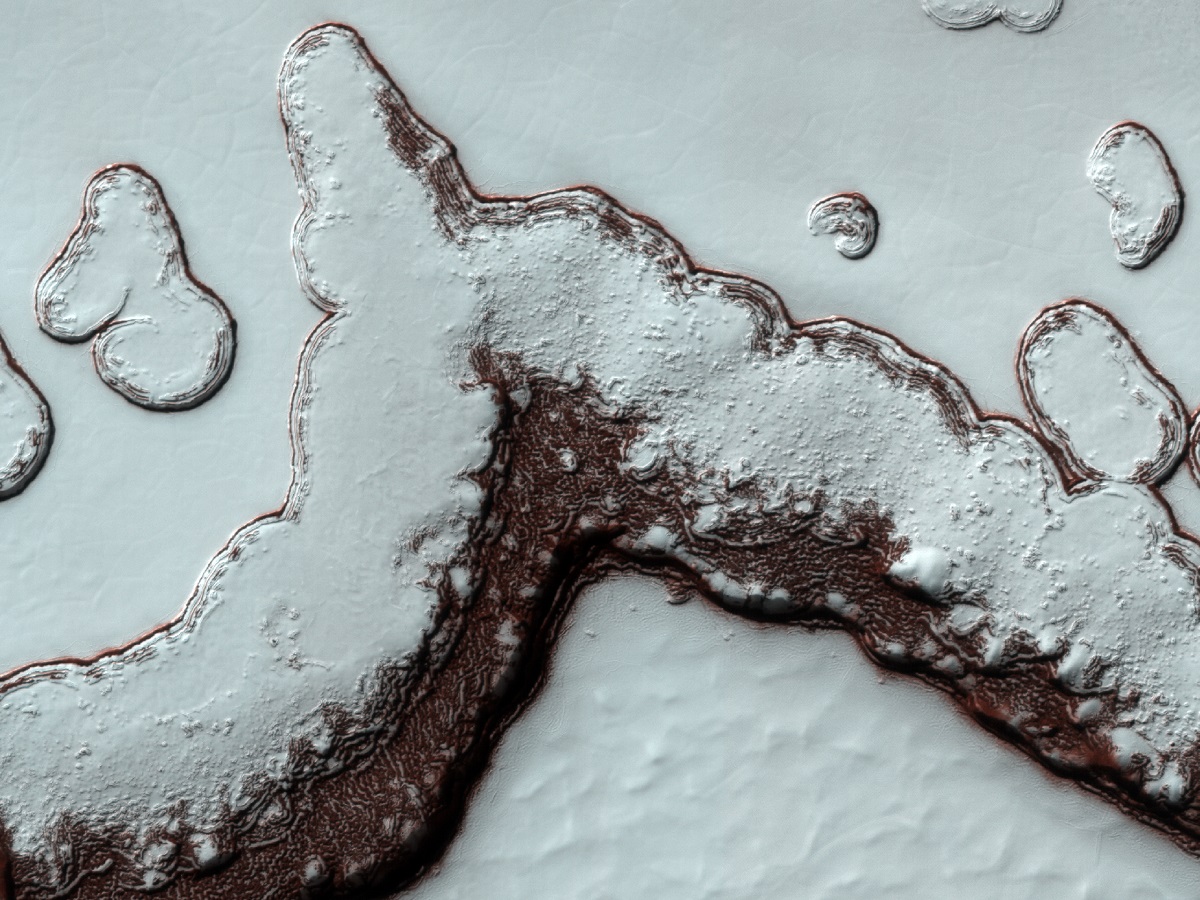 Remains of Summer at the South Pole
Remains of Summer at the South Pole
Potential for Liquid Water
While the current atmospheric conditions on Mars do not support stable liquid water on the surface, there is substantial evidence that liquid water existed on the Martian surface in the distant past. Today, scientists posit that water exists in the form of ice beneath the Martian surface, and recent discoveries suggest the presence of briny, or salty, subterranean lakes, bringing hope to the possibility of microbial life on Mars.
Exploration and Research
The Martian climate has been a subject of extensive research and exploration, spearheaded by various missions like the Mars Rovers and orbiters. These missions have provided invaluable data, allowing scientists to decipher the intricate patterns and phenomena of Mars’ climate. The relentless pursuit to understand Mars’ climatology is driven by the quest to uncover the planet’s secrets, including its geological history, the existence of life, and the potential for human habitation.
Quick Facts
Mars, often dubbed the “Red Planet”, stands out as a beacon of intrigue and exploration in our solar system. Its proximity and similarities, albeit with stark differences, to Earth make it a focal point for astronomers, planetary scientists, and the general public. Let’s explore some quick yet insightful facts about Mars.
Average Distance from Sun: 141.6 million miles (227.9 million km)
Mars orbits the Sun at an average distance of approximately 141.6 million miles (227.9 million kilometers). This distance places it fourth in line from the Sun, right after Earth. It’s this proximity to our planet, combined with its relatively similar tilt on its axis, that gives Mars seasons akin to Earth, albeit they last roughly twice as long due to Mars’ longer orbit around the Sun.
The distance from the Sun also impacts Mars’ climate. Being farther than Earth, Mars receives less sunlight, which, combined with its thin atmosphere, results in the planet being significantly colder than Earth. Its orbital eccentricity or how elliptical its orbit is, also causes variations in temperatures and atmospheric pressure. When Mars is closest to the Sun in its orbit, a position known as perihelion, it experiences dust storms due to the increase in temperature.
Length of Day: 24.6 hours
A Martian day, often referred to as a “sol”, is remarkably close in length to an Earth day. Clocking in at about 24.6 hours, this similarity has practical implications, especially for human exploration. When rovers are operated on Mars, scientists and engineers on Earth often shift to “Mars time” for the first few months, adjusting their schedules to fit the slightly longer Martian day.
The axial tilt of Mars, at 25.2 degrees, is also close to Earth’s axial tilt of 23.5 degrees. This similar tilt, combined with the day’s length, results in Mars having seasons like those on Earth. However, given its longer year (approximately 687 Earth days), each Martian season lasts about six Earth months.
Surface Temperature: -243°F (-153°C) to 68°F ( 20°C)
-243°F Mars exhibits a wide range of temperatures, and its average surface temperature hovers around a chilly -112°F (-80°C). However, during the day, equatorial regions can experience temperatures that climb up to a relatively balmy 68°F (20°C). Conversely, in the depths of a Martian winter night, temperatures can plummet to a bone-chilling -243°F (-153°C).
Several factors contribute to these temperature extremes. First, Mars’ distance from the Sun means it receives less solar energy. Second, its thin atmosphere is poor at trapping heat, leading to rapid temperature drops during the night. Additionally, the planet’s lack of a significant magnetic field and the reduced greenhouse effect, due to the thin atmosphere, further contribute to its cold environment.
The vast temperature fluctuations also play a role in the planet’s weather phenomena. The sublimation and deposition of carbon dioxide at the poles, combined with the temperature-driven processes, lead to dust storms, some of which can engulf the entire planet.
Moons of Mars
The allure of Mars isn’t limited to its rusted valleys and towering volcanoes; the Red Planet’s two tiny moons, Phobos and Deimos, offer equally intriguing tales. Both moons, contrasting with the spherical shapes of our Moon and many others in the solar system, are potato-like in appearance, suggesting a turbulent past. Let’s dive deeper into the stories of these celestial companions.
Phobos: The Doomed Moon
Phobos, the larger of Mars’ two moons, is an enigma that’s drawn considerable interest from scientists. It orbits closer to its host planet than any other moon in the solar system, a mere 3,700 miles (6,000 kilometers) from the Martian surface. This proximity presents a visual spectacle; if one stood on Mars, Phobos would appear about one-third the diameter of our Moon from Earth, zipping across the sky in a mere 4.6 hours!
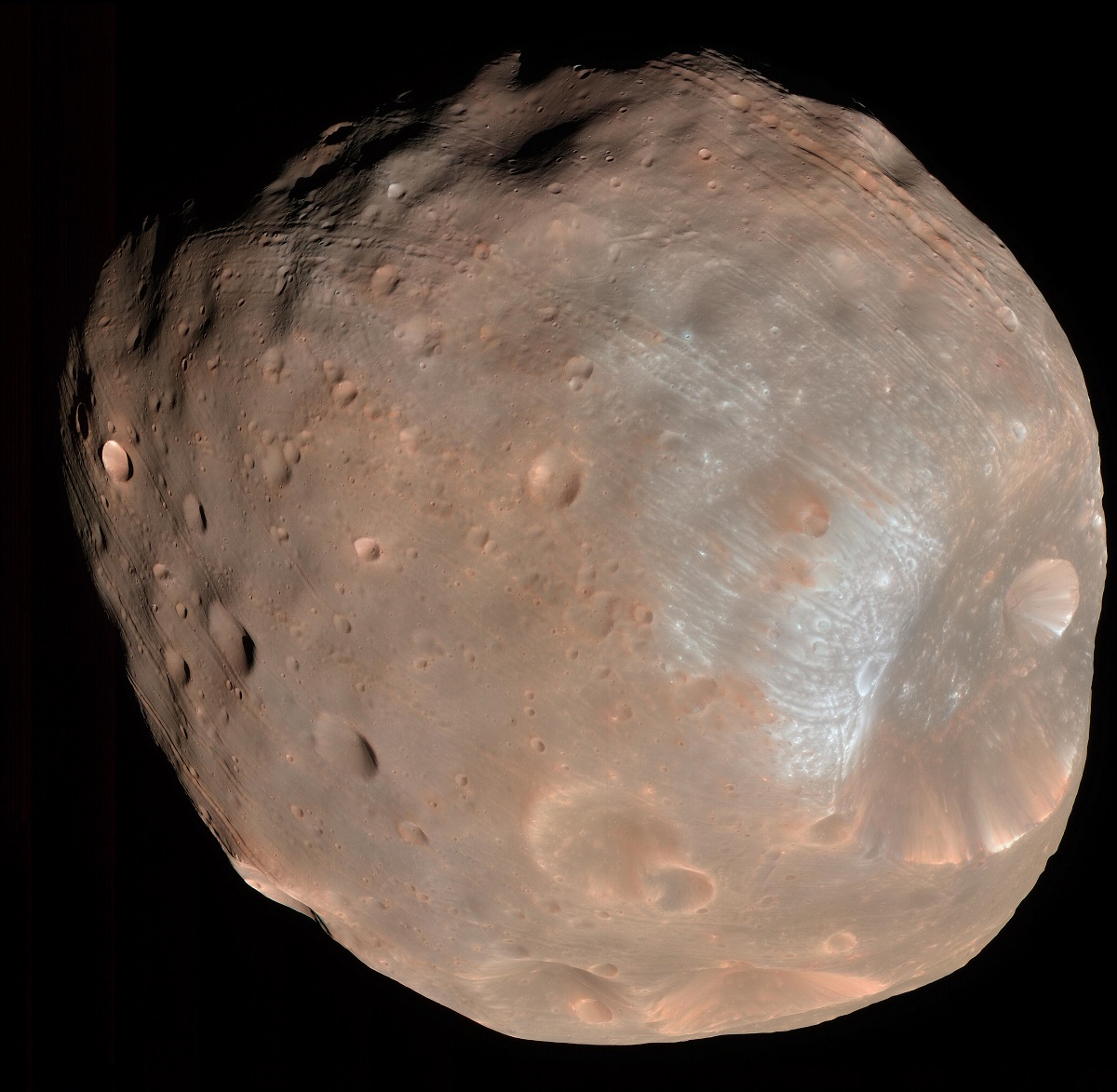 Phobos Mars Moon
Phobos Mars Moon
The unique characteristics of Phobos extend beyond its swift orbit. Due to its proximity, tidal forces exerted by Mars are causing Phobos to spiral inwards at a rate of about 2 meters every century. This has given rise to the widely accepted prediction that Phobos is destined for a dramatic demise. In approximately 50 million years, the moon will either crash into Mars, creating a significant impact event, or it might succumb to tidal forces beforehand, tearing it apart and possibly forming a transient ring around the planet.
The surface of Phobos is intriguing in its own right. It’s scarred by craters, with the most prominent one being Stickney, a colossal impact crater that stretches 9 kilometers (about 5.6 miles) in diameter. The moon’s irregular shape, combined with such massive craters, leads scientists to believe that Phobos has undergone significant traumatic events, barely surviving some of them.
Deimos: The Distant Sibling
While not as close or as dramatic as Phobos, Deimos is captivating in its serenity. Orbiting at about 14,580 miles (23,460 kilometers) from Mars, Deimos takes a more leisurely 30.3 hours to complete its orbit. From the Martian surface, it would appear as nothing more than a bright star, albeit one that moves noticeably against the backdrop of the cosmos.
Deimos is smoother than Phobos, its craters filled with regolith, which gives it a somewhat sandblasted appearance. This regolith layer, possibly several meters deep, suggests that like Phobos, Deimos has seen its share of impact events. However, the moon’s relatively distant orbit and smaller size might have shielded it from some of the more catastrophic events that its sibling endured.
Origin Theories
The irregular shapes of Phobos and Deimos have led scientists to theorize that both moons are captured asteroids from the nearby asteroid belt. Their spectra, angles of inclination, and certain compositional elements bear resemblance to those of D-type asteroids, which are common in the outer asteroid belt. This theory, if proven, could provide insights into the early solar system and the primordial materials from which planets formed.
However, not all are convinced of the captured-asteroid theory. Some scientists argue that the moons may have formed from debris ejected after a massive object collided with Mars. This would parallel the leading theory of our Moon’s formation following a colossal impact event on Earth.
Hydrology of Mars
Water, the vital ingredient for life as we understand it, plays a central role in our quest to understand Mars’s history and its potential to harbor life. Although today’s Martian landscape might appear barren and dry, clues scattered across its surface hint at a past where water may have flowed freely. In this section, we cover the hydrology of Mars, from its ancient rivers to its hidden ice reservoirs.
Evidence of Ancient Water
The topography and geology of Mars are dotted with signs suggesting that liquid water was once prevalent. Ancient river valleys, dried-up lake beds, and delta formations provide compelling evidence of a time when water flowed on the planet’s surface. The size and morphology of some of these valleys indicate they were carved by vast volumes of water, possibly during heavy rainfalls or melting of ice.
Moreover, specific minerals found on Mars, such as clay minerals and sulfates, are known to form in liquid water. The discovery of these minerals by orbiters and rovers further bolsters the claim that parts of Mars were once wet, potentially for extended periods.
Today’s Frozen Reserves
While liquid water’s stable existence on the Martian surface is not possible due to the planet’s thin atmosphere and low temperatures, significant amounts of water ice are hidden beneath. Recent missions and studies have highlighted vast reservoirs of subsurface ice, some of which are believed to be only meters below the ground.
The poles, in particular, are a focal point for Martian hydrology. Both the North and South poles have polar ice caps, akin to Earth’s polar regions. These caps, composed of layers of water ice and carbon dioxide ice, expand and contract with the changing seasons. The Northern polar cap, primarily made of water ice, can be up to three kilometers thick.
The Potential for Liquid Water
While stable liquid water might not exist on the surface, there are indications that transient flows of briny water, or “brines,” might occur under specific conditions. These brines can form when salts present on Mars absorb water vapor, reducing the melting point of ice. Observations from orbiting spacecraft have detected dark streaks, known as recurring slope lineae, on some slopes during warm seasons. Some scientists believe these streaks could be the result of brines flowing temporarily.
Furthermore, in 2018, scientists announced the potential discovery of a subglacial lake beneath the South polar ice cap. Using radar data from the European Space Agency’s Mars Express mission, they detected what appeared to be a 20-kilometer-wide body of liquid water. If confirmed, such reservoirs could be crucial in the search for Martian life and invaluable resources for future human missions.
Implications for Life
The history of water on Mars naturally leads to questions about life. On Earth, where there’s water, there’s often life. If Mars had persistent liquid water in the past, it raises the tantalizing possibility that microbial life might have once existed. Furthermore, if briny water exists today, even transiently, it could provide niches where extremophile organisms might survive.
Challenges and Future Exploration
Mars’ hydrology presents both challenges and opportunities for future exploration. While the presence of water ice can be harnessed for future manned missions—for drinking, as a resource for oxygen, and as fuel after being split into hydrogen and oxygen—the potential of brines or subglacial lakes can pose risks. They can be harmful to human explorers and equipment, and care must be taken not to contaminate these environments, preserving them for scientific study.
Astronomical Data
The allure of Mars extends beyond its rust-colored deserts and the potential for hidden life. Its astronomical characteristics and behavior offer a unique insight into planetary mechanics, atmospheric conditions, and potential for human exploration. By analyzing into the astronomical data of Mars, we gain a deeper understanding of the Red Planet’s place in our solar system.
Orbital Dynamics
Mars, the fourth planet from the Sun, showcases an elliptical orbit, more elongated than Earth’s. Completing a full orbit around the Sun in approximately 687 Earth days, Mars’s journey defines what’s called a Martian “solar day” or “sol.” This orbital period constitutes the Martian year.
However, the elliptical nature of Mars’s orbit leads to some fascinating phenomena. For instance, Mars’s distance from the Sun varies significantly throughout its orbit. This variation results in seasons that differ in length. Mars’s closest approach to the Sun is termed “perihelion,” and its most distant point is called “aphelion.” The difference in distance between these two points plays a crucial role in the severity and duration of Martian seasons.
The Tilt and Seasons of Mars
Much like our home planet, Mars has a tilted axis. Its axial tilt, or obliquity, is around 25.2°, remarkably close to Earth’s 23.5°. This tilt ensures Mars experiences seasons similar to Earth. However, there are notable differences.
Due to Mars’s elongated orbit and its orbital dynamics, its seasons aren’t of equal length. The northern hemisphere’s spring is the longest season, lasting about seven months, while its winter is the shortest at just over four months. Conversely, in the southern hemisphere, summer is the longest season, and autumn is the shortest.
The axial tilt, combined with the elongated orbit, also results in more extreme seasonal changes, especially in the southern hemisphere. Summers are hotter and winters colder than those in the northern hemisphere.
The Martian Day
A Martian day, known as a “sol,” is very close in length to an Earth day but slightly longer. It clocks in at about 24.6 hours. This similarity in day length, combined with the presence of a tilted axis causing seasons, makes Mars’s day-night cycle and seasonal variations somewhat relatable to Earth’s, despite the many other differences between the two planets.
Atmospheric Considerations
While Mars’s astronomical data gives us insights into its position and movement in space, the planet’s thin atmosphere plays a vital role in determining its surface conditions. Even though Mars receives about half of the sunlight Earth does, its lack of a significant atmosphere causes greater fluctuations in temperature. Nights can be piercingly cold, and days, especially during summer at the equator, might get warm enough for water to flow briefly. However, the average temperature remains far colder than Earth’s.
Celestial Synchrony with Earth
As Mars orbits the Sun, its position relative to Earth changes, leading to periodic events such as “oppositions.” An opposition occurs when Mars, Earth, and the Sun align, with Earth positioned between the Sun and Mars. During opposition, Mars appears brighter in the night sky and is visible for most of the night. This event provides prime viewing opportunities for astronomers and is often the best time to launch missions to Mars due to the reduced distance between the two planets.
Significant Discoveries
Mars, once considered a barren, lifeless wasteland, has transformed in the eyes of humanity through a series of groundbreaking discoveries. These findings, each significant in its own right, have reshaped our understanding of the Red Planet and the broader story of life and geology in our solar system. Among these revelations, the evidence of ancient water, the presence of organic molecules, and the enigmatic seasonal methane releases stand out as some of the most profound.
Ancient Water: The Legacy of a Wet Mars
One of the most significant paradigm shifts in Mars research is the discovery of evidence pointing to its watery past. For years, the idea of liquid water existing on Mars was a matter of speculation. However, high-resolution imagery and data from Mars missions have provided undeniable evidence of this.
Ancient river valleys, deltas, and vast lake beds have been identified on the Martian surface. These geological formations closely resemble those found on Earth and are formed by the sustained flow of water over a long period. Features like the existence of pebbles and conglomerates on Mars, which can only be formed by moving water, further substantiate this claim.
Gale Crater, explored by the Curiosity rover, is one such site. Once believed to be a lake filled with liquid water, the layers of sediment in this crater provide a chronological record of Mars’s changing environment and its transition from a warm, wet planet to the cold desert it is today.
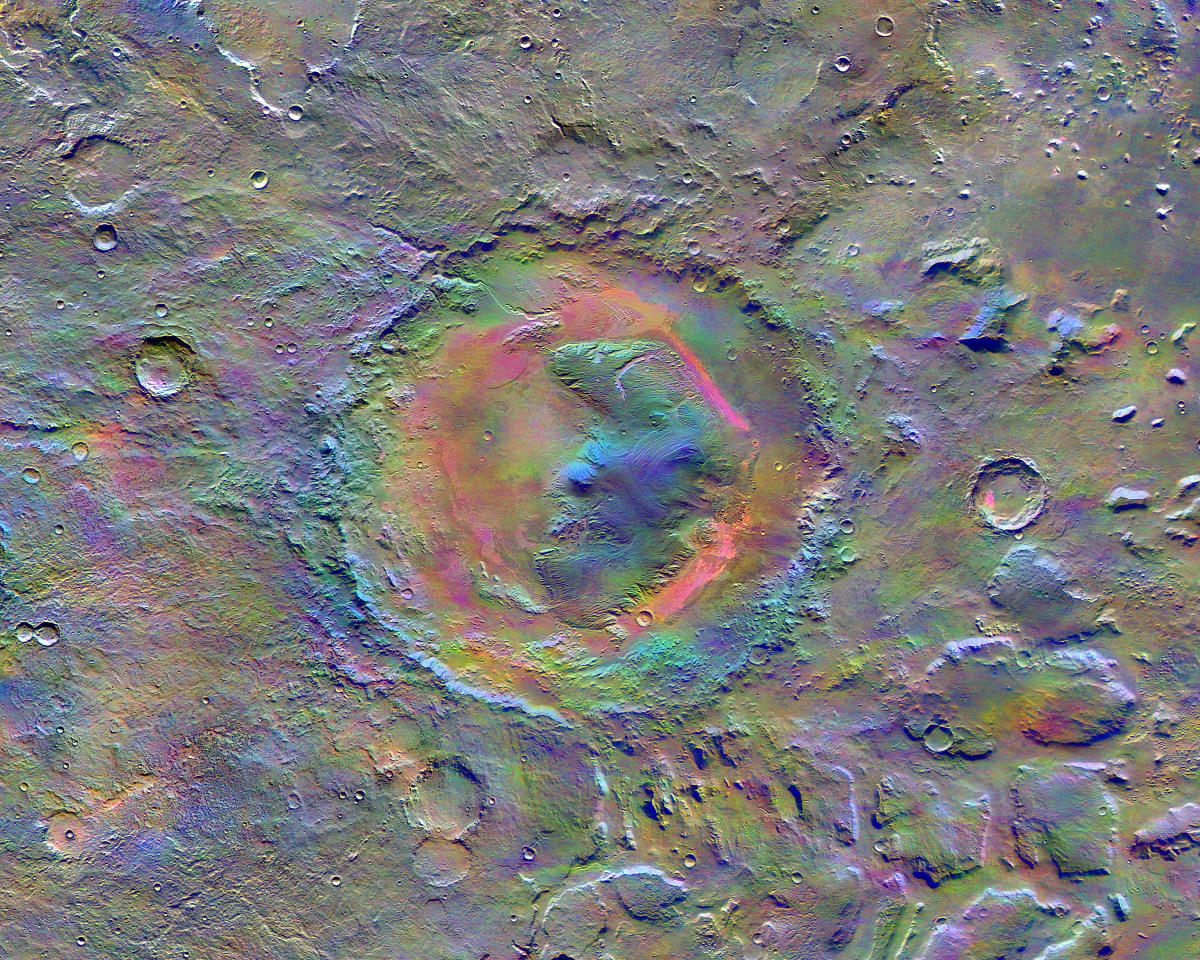 Gale Crater Minerals
Gale Crater MineralsOrganic Molecules: A Step Closer to Understanding Martian Life
Perhaps one of the most exciting discoveries on Mars is the detection of organic molecules in ancient rocks. Unearthed by the Curiosity rover from 3-billion-year-old mudstone in Gale Crater, these molecules could be indicators of potential life in Mars’s history.
Organic molecules are the building blocks of life as we know it. Their presence does not directly equate to life but suggests conditions that could have been conducive to life. The molecules found on Mars are consistent with the ones associated with life on Earth, leading scientists to postulate various theories. Some believe these could be remnants of ancient Martian microbes, while others speculate they might have been formed through non-biological processes.
Seasonal Methane: Life or Geology at Play?
The Martian atmosphere’s seasonal methane releases have added another layer to the enigma surrounding the Red Planet. Methane, while present in scant quantities on Mars, is significant because of its potential biological implications.
Methane can be produced by both biological (like microbes) and non-biological (such as water-rock chemistry) processes. On Earth, a significant portion of atmospheric methane is produced by living organisms. The seasonal pattern of methane releases, which peaks in the Martian summer, is particularly puzzling. Such a pattern hints at a possible biological origin, as certain microbes on Earth produce methane when they metabolize.
However, there’s also a strong case for geological explanations. Mars is known to have vast reserves of underground ice. When this ice interacts with certain rocks, it can produce methane. This, coupled with the lack of definitive evidence for current life on Mars, makes the methane mystery one of the most debated topics in Martian science.
Scientific Missions
Mars, with its tantalizing mysteries, has been the focal point of numerous scientific endeavors. From the early days of space exploration to the state-of-the-art missions of today, our drive to understand the Red Planet has led to a series of groundbreaking journeys. These missions, initiated by various nations, have collectively deepened our grasp on Mars and have paved the way for future endeavors.
NASA’s Early Ventures: Pioneering Exploration
The Viking missions in the 1970s marked some of NASA’s earliest and most ambitious efforts to study Mars. Comprising two spacecraft, Viking 1 and Viking 2, each mission included both an orbiter and a lander. These missions aimed to photograph the surface, search for signs of life, and understand the planet’s atmosphere and geology.
The Viking landers conducted the first successful soil experiments on another planet, hoping to detect microbial life. Although they found no direct evidence of life, they sent back crucial data on the Martian soil and weather. The images from the Viking orbiters provided a comprehensive view of Mars, reshaping our understanding of its terrain and geology.
The Perseverance Rover & Ingenuity Helicopter: A New Age of Exploration
Launched in July 2020, NASA’s Perseverance rover represents the pinnacle of modern Martian exploration. Tasked with searching for signs of ancient life and collecting samples for potential return to Earth, Perseverance is equipped with a suite of advanced scientific instruments.
One of the mission’s highlights has been the deployment of the Ingenuity helicopter, a technological marvel. As the first powered flight on another planet, Ingenuity’s flights are more than mere experiments; they herald a potential revolution in how we explore celestial bodies. Offering aerial perspectives of regions inaccessible to rovers, helicopters like Ingenuity could drastically reshape future interplanetary missions.
The European Space Agency (ESA): An International Pursuit
The European Space Agency, through collaborations with countries like Russia, has made significant strides in Martian exploration. The Mars Express orbiter, launched in 2003, has been instrumental in understanding Mars’s atmosphere, geology, and potential subsurface water sources.
Building on Mars Express’s success, ESA and Roscosmos (the Russian space agency) have embarked on the ExoMars program. Comprising an orbiter, a failed landing demonstrator, and a planned rover (named Rosalind Franklin), the program aims to search for signs of life, past or present. The Trace Gas Orbiter, part of this mission, has been instrumental in studying the Martian atmosphere, particularly the mystery of the aforementioned seasonal methane.
India’s Mangalyaan: A Symbol of Aspiration
The Mars Orbiter Mission (MOM), colloquially known as Mangalyaan (meaning “Mars-Craft” in Sanskrit), was launched by the Indian Space Research Organisation (ISRO) in 2013. As India’s first interplanetary venture, Mangalyaan had a dual purpose: technological demonstration and scientific exploration.
Despite being a maiden voyage, Mangalyaan was a resounding success. It made India the first Asian nation to reach Martian orbit and the first in the world to do so on its inaugural attempt. Scientifically, the orbiter was equipped to study the Martian surface, morphology, and atmosphere. Among its many achievements was the detection of a dust storm over the northern hemisphere and the successful measurement of Mars’s two moons’ albedo.
Other Nations, Shared Visions
Other countries have also expressed their interest and made attempts to explore Mars. For instance, China’s Tianwen-1 mission, which includes an orbiter, a lander, and the Zhurong rover, was initiated to study the Martian environment and geology. The United Arab Emirates’ Hope Probe, primarily an atmospheric study mission, marked the Arab world’s first interplanetary endeavor.
Frequently Asked Questions
Mars, as a subject of perennial human curiosity, has raised numerous questions. While many of these questions find their answers through scientific exploration, some still linger and continue to boggle the minds of experts and enthusiasts alike. Here’s an in-depth look at some of the most commonly asked questions about the Red Planet.
Can humans live on Mars?
The notion of humans colonizing Mars has been a topic of fascination, both in scientific circles and popular culture. However, living on Mars presents a myriad of challenges that need to be addressed before any sustainable human presence can be established.
Martian Atmosphere: Unlike Earth’s breathable atmosphere, Mars has a very thin atmosphere, with carbon dioxide comprising over 95% of it. This makes it impossible for humans to breathe without life support systems.
Cold Temperatures: Mars is much colder than Earth, with average temperatures around minus 80 degrees Fahrenheit (-62°C). Surviving these frigid conditions would require specialized habitats and suits to maintain a livable temperature for humans.
Radiation: Without a strong magnetic field and a dense atmosphere to shield its surface, Mars is bombarded with harmful radiation from the sun and cosmic rays. Prolonged exposure can have detrimental effects on human health.
Gravity: Mars has only about 38% of the Earth’s gravity. While this might sound fun, in the long run, the effects of reduced gravity on the human body are not entirely understood but could include muscle atrophy and bone density loss.
Technological Solutions: For humans to live on Mars, they would need self-sustaining habitats with life support systems capable of providing air, water, and food. Advanced technologies, some of which are in developmental stages, would be essential for extracting resources from Mars to support a human colony.
Is there life on Mars?
The question of life on Mars has captivated humanity for decades. While our scientific endeavors have provided some answers, the mystery remains unresolved.
Past Life: Several missions to Mars have found evidence suggesting that the planet might have had conditions favorable for life in its ancient past. The presence of ancient river valleys, lake beds, and organic molecules in 3-billion-year-old rocks hints at a time when microbial life could have existed.
Current Life: As of now, there is no direct evidence of life on present-day Mars. However, the seasonal releases of methane and the discovery of subsurface liquid water reserves have reignited discussions about the possibility of microbial life lurking beneath the surface.
Future Explorations: The search for life, past or present, remains one of the primary objectives of Mars missions. Future missions, equipped with more advanced tools and instruments, might finally provide a definitive answer to this age-old question.
Why is Mars red?
The distinctive reddish hue of Mars, which led to its moniker, the “Red Planet,” is a result of its surface composition.
Iron Oxide: The Martian soil and dust are rich in iron oxide, commonly known as rust. When iron reacts with oxygen, it forms iron oxide, imparting a reddish color to the surface.
Weathering Process: Over billions of years, the iron minerals in Mars’s soil reacted with trace amounts of oxygen and water from the atmosphere. This weathering process gave rise to the abundant iron oxide on the surface.
Reflection of Sunlight: The fine iron oxide particles on Mars’s surface reflect sunlight in a manner that accentuates the red wavelengths, further enhancing the planet’s reddish appearance when viewed from space.
Mars, with its myriad of secrets, continues to capture our collective imagination. While it poses significant challenges, the potential it holds — from understanding its past to possibly hosting future human colonies — is vast. As we continue our exploration, we step closer to deciphering the mysteries of the red planet.
More About Mars
Contact us today to learn more about our 3D services and how we can help you achieve your goals.
